:max_bytes(150000):strip_icc():format(webp)/GettyImages-664800650-4349941504c24712b81975694798236b.jpg)
Updated In 2024, Looking for a Change? 13 Top Windows Movie Maker Alternates

Looking for a Change? 13 Top Windows Movie Maker Alternates
Windows Movie Maker has been a cornerstone tool for video editors for quite a while. There are a lot of amateurs who’ve made use of the free program and have done wonders with it. As it is discontinued, many Windows Movie Maker alternatives claim to offer ‘just the right video editing tool for you,’ few can live up to their promises—and most are very expensive.
We have ten other programs that can be used to create videos that include everything from Apple iMovie to other basic alternatives.
So whether you’re a beginner who wants to learn how to make a movie, a pro looking for an excellent alternative to Windows Movie Maker, or someone who wants to make a simple slide presentation or online video, you’re bound to find a video creation program here.
- Wondershare Filmora
- Avidemux Video Editor
- VirtualDub
- Sony Vegas Movie Studio
- WeVideo
- Lightworks
- ShotCut
- OpenShot
- Movavi Video Editor Plus
- VSDC Free Video Editor
- VideoPad Video Editor
- HitFilm
- Magix Movie Studio
- How To Edit a Video With a Windows Movie Maker Alternative
- Hot FAQs on Windows Movie Maker Alternatives
Part 1: Top 3 Picks for Windows Movie Maker Alternatives
The world’s best video editing software is about to change. We look at three of the most popular and valuable alternatives to Windows Movie Maker.
You will need to consider these alternatives to ensure they meet your expectations and needs.
1. Wondershare Filmora - Best Overall

Filmora is the best Windows Movie Maker Alternative designed according to your convenience.
Ratings: 4.4 Stars out 5
Starting from $49.99
2. Magix Movie Studio - Best for Collages

This alternative offers a variety of tools and plugins for anyone who wants to create professional-level videos in under a minute.
Download on Windows
Ratings: 4 stars out of 5
30-day free trials, then starts from $69.99 all the way to $129
3. Avidemux Video Editor - Best Open-Source Editor

An open-source editor that supports a wide range of formats is free! Avidemux has an interface similar to Windows Movie Maker, which makes it a perfect alternative.
Download on Windows
Ratings: 4.0 stars out of 5
Free Trial
Part 2: Ultimate Overview on 13 Best Alternatives to Windows Movie Maker
We live in visual culture, and we constantly see, capture, upload, and share videos on our smartphones, tablets, and laptops. So, it is only natural that more people seek ways to edit their videos. Windows Movie Maker was one of the most popular video editing apps. So it’s time to dig into the best Windows Movie Maker alternatives, which are arguably better and feature-rich.
| Software | OS | Media Resources | AI editing | Easy to Use | Free Trial |
|---|---|---|---|---|---|
| Wondershare Filmora | WindowsMacMobile | Yes | Yes | Yes | Yes |
| Avidemux | WindowsOS XLinuxBSD | Yes | No | Yes | Yes |
| Virtual Dub | Windows | No | No | Yes | Yes |
| Vegas Movie Studio | Windows | Yes | Yes | No | No |
| WeVideo | Online | Yes | No | Yes | Yes |
| Lightworks | LinuxOS X Windows | Yes | Yes | No | No |
| ShotCut | WindowsMacLinuxBSD | Yes | No | No | Yes |
| OpenShot | WindowsMacLinuxChrome OS | Yes | No | Yes | Yes |
| Movavi Plus | WindowsMac | Yes | No | Yes | Yes |
| VSDC | Windows | Yes | No | Yes | Yes |
| VideoPad | WindowsMaciPad/iPhone | Yes | No | Yes | Yes |
| HitFilm | WindowsMac | Yes | Yes | Yes | Yes |
| Magix Movie Studio | Windows | Yes | Yes | No | Yes |
Part 3: 13 Best Windows Movie Maker Alternatives for Windows
As we all know, Windows Movie Maker is the most used and trusted tool for creating videos in Windows. With its unique features and user-friendly interface, people often use this software to develop short and entertaining videos.
However, the fact is that Windows Movie Maker is not the current best video editing software for creating complex video projects. For this reason, we compiled a list of the 12 best alternatives to offer you a better option for Windows Movie Maker.
1. Wondershare Filmora
Filmora 11 is a powerful, easy-to-use video editor specially designed to streamline your workflow and save you hours weekly. It supports everything from Windows, Mac, and IOS to Android. The latest update to the flagship app includes several key enhancements that result in a much more efficient video creation workflow and one that’s easier to use than its rivals.
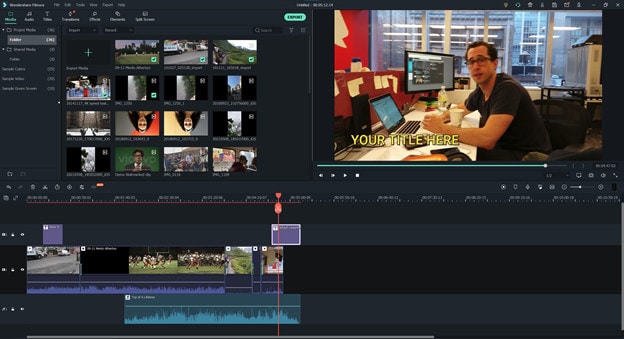
Key features
- Preset Templates
- Instant Mode
- Motion Tracking
- AI Editing Effects
- Auto Synchronization
- Plug-ins
Price
- Annual Plan: $49.99
- Perpetual Plan: $79.99
Pros
- Seamless interface for beginners
- Great customer support
- Plenty of effects and preset templates
- 4K video output options
Cons
- Rendering requires too much time
- The mobile app requires separate subscription
Supported OS: Windows , Mac , iOS , Android , iPad
G2 Ratings: 4.4 stars out of 5
Summary
Filmora’s intuitive interface allows experienced and brand-new users to create incredible videos with flawless special effects. Its high ratings and multiple supported formats make it quite popular among users.
2. Avidemux Video Editor
If you are a beginner and want to use a free, open-source software program for basic video editing, then Avidemux is a good choice. The interface is not as fancy as it could be, but there are some presets that’ll save you a lot of time. Avidemux is a cross-platform video editor that allows you to create custom videos, but it doesn’t feature the ability to share the edited footage to social media directly,
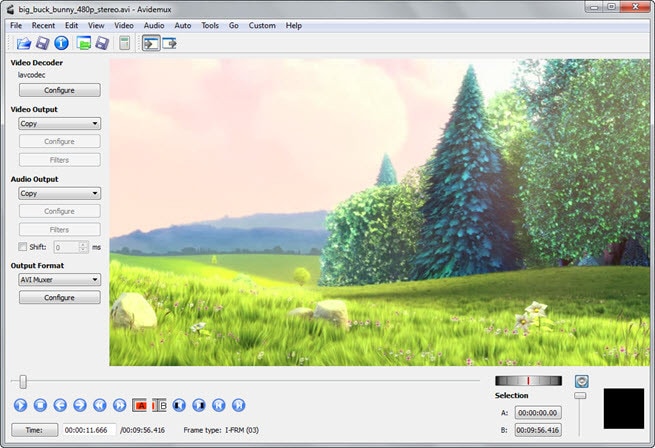
Key features
- Video and Audio Filters
- Support Popular Formats
- Convert Video For Archiving or Publishing
Price: Free
Pros
- It can convert Video To A Smaller Size
- Easy cut, trim, split video
Cons
- Out-dated UI
- Lacks sharing option
Supported OS: Windows , OS X , Linux , BSD
Uptodown Ratings: 4.0 stars out of 5
Summary
An open-source video editor that supports most formats. Due to its obsolete UI and lack of sharing features, Avidemux has average ratings.
3. VirtualDub
This open-source software is user-friendly and allows users with little experience to navigate the software without much trouble. It supports 3rd party apps and also offers batch-processing, which means working on multiple videos simultaneously makes it possible.
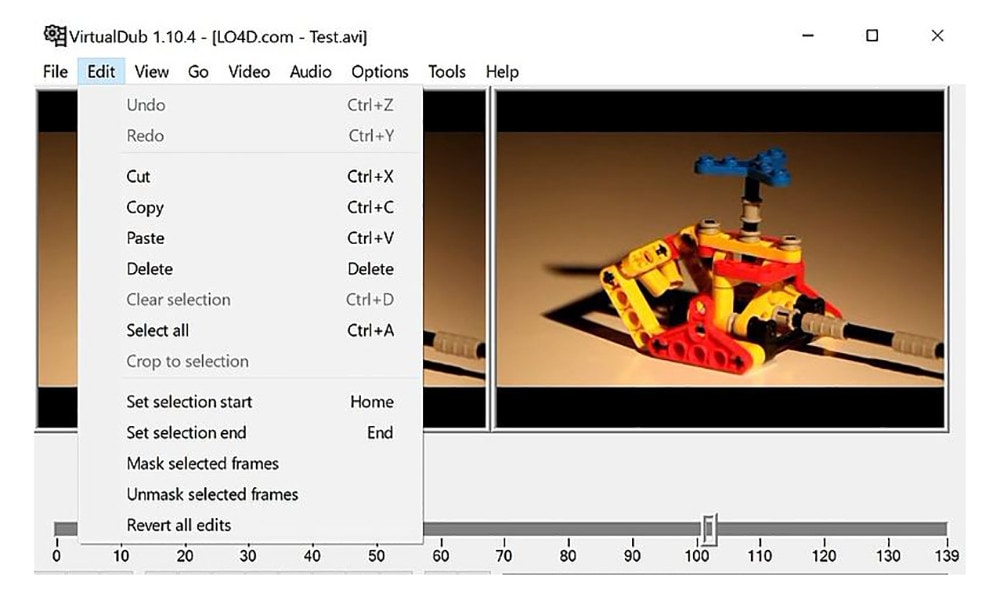
Key features
- Integrated volume and histogram meter
- Optimized disk
- Noise reduction
- Fractional frame rates
Price: Free
Pros
- Clean interface, easy to use
- Keyboard and mouse shortcuts for faster operation
- Free to use
Cons
- Not suitable for 4K editing
- Lack learning material
- Obsolete Interface
Supported OS: Windows
Compare Camp Ratings: 4.0 stars out of 5
Summary
Virtual Dub supports multitasking, and its features are pretty helpful. However, it lacks 4k editing and a friendly interface. Overall Virtual Dub is a good choice.
4. Sony Vegas Movie Studio
This video editing software makes it easy to create professional-looking videos in minimum time and effort. Vegas Movie Studio software is best for video editing professionals who have been doing it for some time and are looking for something a little more sophisticated than free alternatives. Not only does it has a high retail price, but its internal elements can be too complex for those just beginning.
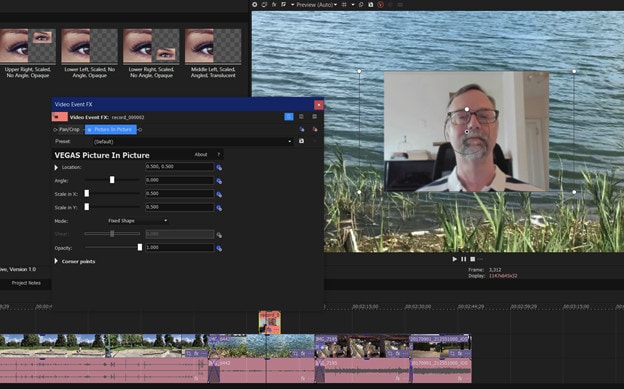
Key features
- Color correction
- HDV and AVCHD-editing
- DV batch capture
- Wide variety of file formats and codecs
Price: Starting from $7.99 USD per month
Pros
- Customizable interface
- Multicam editing
- Lots of effects and transitions, with plug-in capability
- Good slow motion and warp flow transition tools
Cons
- Less intuitive interface than competitors
- Import from camcorder not ideal
- Some tools are complex
Supported OS: Windows
G2 Ratings: 4.4 out of 5
Summary
Vegas Movie Studio is the choice of professionals. It does all the work without taking up a lot of resources, and like most programs, there is a learning curve. It’s not always intuitive for beginners, but its professional and powerful features score decent in most reviews.
5. WeVideo
This cloud-based application is a simple-to-use video editing and sharing suite. WeVideo is a full-featured video editing application that uses JumpStart technology to create amazing videos. It’s an innovative app that offers a seamless editing experience as it supports multiple formats of video, images, audio, and graphics.
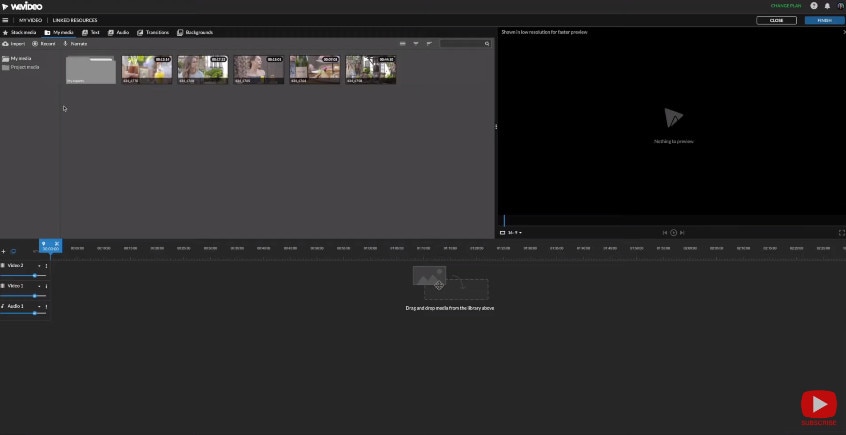
Key features
- WeVideo JumpStart
- Cloud storage
- Built-in graphics
- Customizable environment
- Advanced text editing
- Multi-track editing and storyboard
Price
- Free trial
- Power Plan: $9.99/month
- Unlimited Plan: $15.99/month
- Professional Plan: $39.99/month
- Business Plan: $73.99/month
Pros
- Constantly improving features
- Ease of use
- Storage is cloud-based
Cons
- Old fashion transition
- Leaves a watermark on free trial
Supported OS: Online
Trustpilot Ratings: 4 stars out of 5
Summary
WeVideo is a straightforward yet robust video editor. It offers a variety of features and supports multiple formats, plus its comprehensive pricing plan makes it useful for everyone.
6. Lightworks
Lightworks is the most powerful video editor in its class and an excellent tool for professionals who want to make amazing videos quickly. Lightworks is very fast and straightforward to use, and it has some great features you won’t find in any other video editor. It is available on all popular OS.
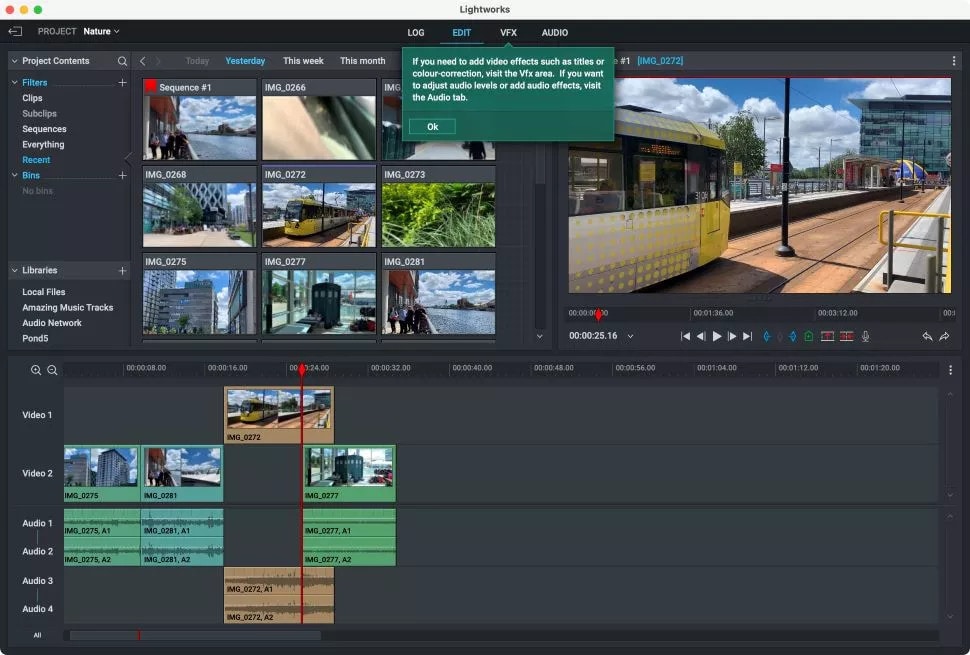
Key features
- Audio and Video Effect Plugin Support
- Cloud Connected
- Motion Graphics
- Advanced Metadata
- Proxy Workflows
- Apple ProRes decoding
Price
- Monthly Plan: $9.99/user
- Yearly Plan: $9.99/user
- Perpetual: $154.99
Pros
- High-resolution timeline rendering
- It has social media export templates
- Interfaces for multiple OS are consistent
- Instant autosave
Cons
- Commands are not always intuitive
- A bit pricey as compared to its competitors
Supported OS: Windows , Mac , Linux
Techradar Pro Ratings: 4 stars out of 5
Summary
Lightworks is not any other video editing tool available on the market of video editing tools. This video editing tool provides amateurs with the most sophisticated features in an optimized platform. Its scores are the highest on almost every review site.
7. ShotCut
Shotcut is a multiplatform video editor that lets you work with various formats for audio, video, image files, etc. This video editor makes it easy to mix and match the resolution and frame rates in a video file. All the changes you make in the editor can be undone and redone often. Shotcut is the best choice for video editing, without question.

Key features
- Webcam capture
- Audio scopes and filters
- Deinterlacing
- Eyedropper tool
- Video wipe transitions
- Keyframes for filter parameters
Price: Free
Pros
- Support for 4K resolutions
- Free
Cons
- Less intuitive than commercial apps
- Lacks built-in sharing to popular sites
Supported OS: Windows , Mac , Linux
GetApp Ratings: 4.5 out of 5 stars
Summary
Shotcut is an open-source video editor for creative professionals and is available on mac, Windows, and Linux. The free version of Shotcut has many excellent features, but it doesn’t have the slick interface or advanced techniques of the top paid editors.
8. OpenShot
An award-winning open-source video editor that creates stunning videos. OpenShot is a fast, easy-to-use, and surprisingly powerful video editor. OpenShot Video Editor allows you to work with many different types of tracks so that your edits will seem natural. OpenShot Video Editor allows you to add your custom animations or titles. The options are endless, so it all depends on your time and interest. It is available in more than 70 languages, making it ideal for all types of users.
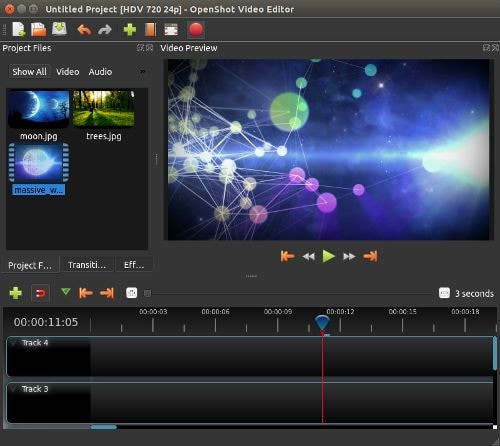
Key features
- 3D animations
- Animation and keyframes
- Multiple languages and formats
- Cross-platform
- Video-effects
Price: Free
Pros
- It is a non-linear editor with infinite tracks
- 100% free without watermark
- Frequent updates
Cons
- Obsolete interface
- Unstable performance
- Lacks some editing features
Supported OS: Window , Mac , Linux , Chrome OS
Getapp Ratings: 4.2 stars out of 5
Summary
Another open-source video-editor in the list is named OpenShot. It’s a multi-lingual and multi-supported app with unique features. Despite its unstable performance, OpenShot is still an ideal choice for many users.
9. Movavi Video Editor Plus
Movavi Video Editor Plus is the perfect tool to bring your creative ideas to life. It has special effects, ready-made intros, and keyframe animation. Using chroma keying, you can change the background of your video clips to any color or pattern that suits your need. Movavi has now redesigned its user interface to make it easy to use.
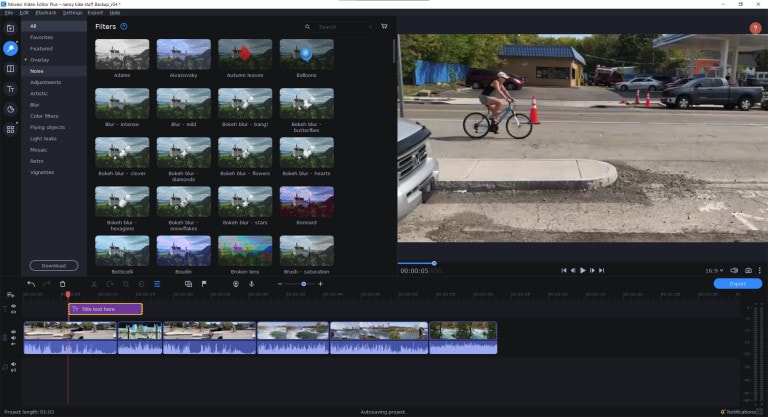
Key features
- Effects and transitions
- Built-in media pack
- Fast processing of 4K videos
- Keyframe animation
- Automatic video creation
- Cutting, trimming, joining
Price
- Free version: 7 days
- Video Editor Plus 1 year /1 PC: $49.95
- Video Editor Plus Lifetime /1 PC: $69.95
- Video Suite Lifetime /1 PC: $89.95
Pros
- Easy-to-understand user interface
- Transitions with sound
- Motion tracking and picture-in-picture tools
- Chroma-key capability
- Quick movie-creation tool
Cons
- Lacks advanced trim modes
- Slow rendering
PCMag Ratings: 4.0 stars out of 5
Summary
If you want to edit your videos with a minimal learning curve, try Movavi. You get PiP, chroma-keying, titling, basic keying, and motion tracking. The program is simple to use but doesn’t have all the features and stands four stars.
10. VSDC Free Video Editor
VSDC Free Video Editor is an online tool that lets you edit audio and video files to make your creations like movies, YouTube tutorial videos, and more. The audio and video files supported are extensive, and the software includes a codec manager. The Pro version isn’t necessary if you’re using the free edition of the software; it’s more than enough to get the job done.
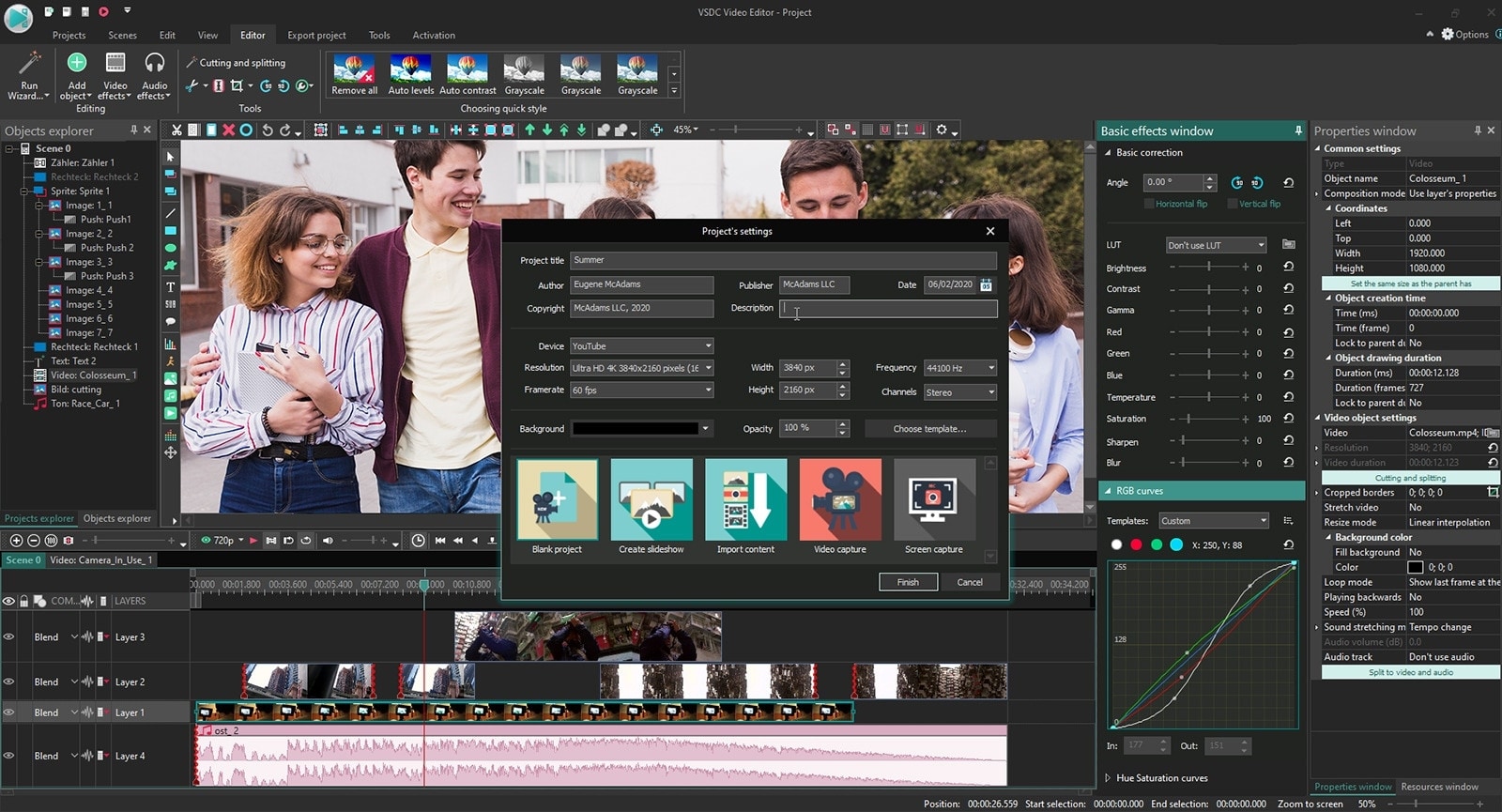
Key features
- Dark theme
- Subpixel Accuracy
- Powerful Chroma Key tool
- Trendy video effects, filters, and transitions
- Color Blending And Filters
- Built-In DVD Burning Tool
Price: Free
Pros
- Non-linear
- Video effects library
- Video stabilization
- Masking
Cons
- Outdated interface
- Lack keyboard shortcuts
- Only available on Windows
Supported OS: Windows
Capterra Ratings: 4.5 stars out 5
Summary
VSDC is a non-linear editor with extensive format support. It includes all the essential features an editor requires but with an obsolete UI. It is also ideal for many who need a powerful yet free video editor.
11. VideoPad Video Editor
VideoPad is a free video editor that can create stunning videos and perform basic editing tasks. A good video editor can help you to create videos for different social media platforms. You can make your videos look professional and polished with a few clicks and some simple editing skills. There’s nothing particularly exciting or advanced about this app; it’s simple enough for anyone new to video editing or even for seasoned editors. But the simple and easy-to-use interface makes the entire process very exciting.
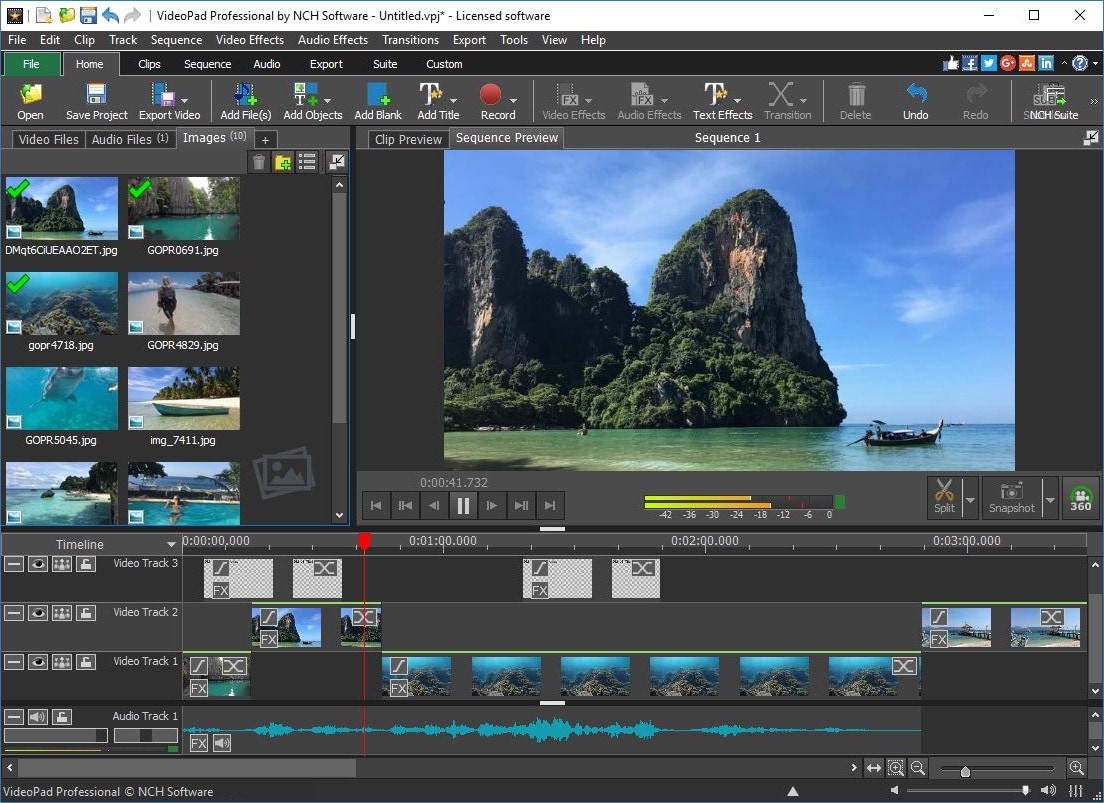
Key features
- Text snippets
- Range of transitional effects
- Plug-ins Library
- Burn finished videos to Blu-Ray, DVD, etc.
- Color correction and light balance.
Price: Free
Pros
- Simple and clean interface
- Supports multiple file formats
- Includes video effects
- Lightweight on system resources
Cons
- Lack of advanced features
Supported OS: Windows , Mac , iPad/iPhone
Tom’s guide Ratings: 3.5 stars out of 5
Summary
Video pad is a free video editor designed for beginners that is lightweight and simple. VideoPad is also great for creating quick videos for social media purposes like Youtube and Facebook. The software has a high rating, as shown above, and it’s available on Windows.
12. HitFilm
HitFilm is a helpful video editing software that makes editing easier for users. In addition to basic features, the program also provides advanced-level functions that make edited videos pop. Hitfilm Express Download has more than 400 features to help casual video editors save time. Features like: visual effects, cinematic elements, and compositing tools preset help unleash your creativity.
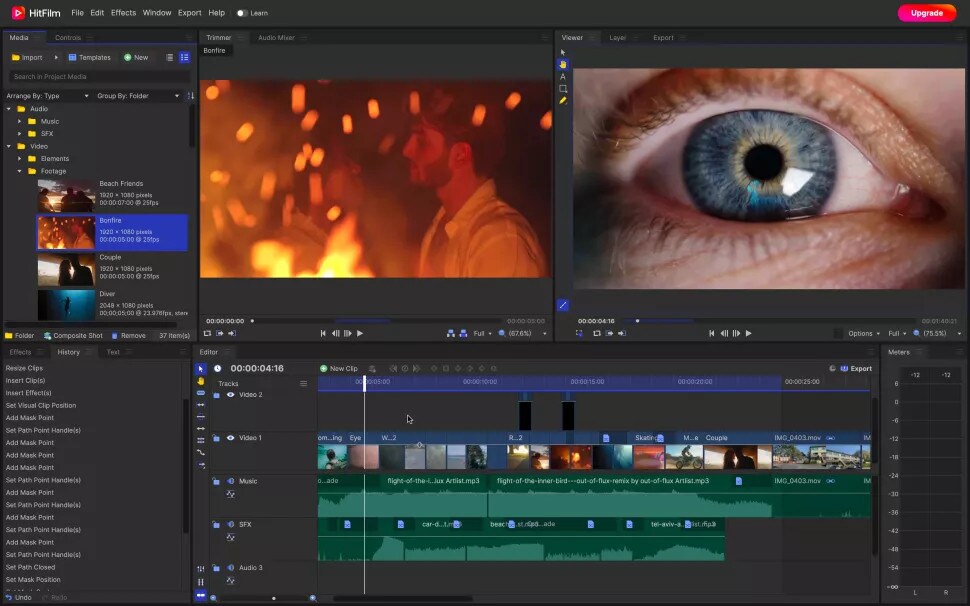
Key features
- Color Grading and correction
- Smart search
- Commentator recorder
- Lightning and lens flares
- 3D camera tracker
Price
- Free trial
- Creator: $7.50
- Pro: $12.50
- Enterprise: Custom pricing
Pros
- Intuitive interface
- It offers free tutorials and masterclasses
- Works on both Windows and Mac
Cons
- It requires heavy system requirements
TechRadar Ratings: 4.5 stars out of 5
Summary
HitFilm Express 15 is a powerful free video editing program that enables you to create high-quality videos in minutes with an intuitive interface. It offers advanced editing features such as advanced video trimming, 3D editing, and more.
13. Magix Movie Studio
Magix is the world’s leading professional audiovisual media software, with Sequoia being its industry-standard audio editing software. This movie editor is an enthusiast-level video editing software that competes with software from Adobe and CyberLink, and it even boasts support for 4K content and 360 degrees. There are many reasons to upgrade. This year’s update includes stabilization, 8K editing, motion tracking, and an in-app plug-in store.
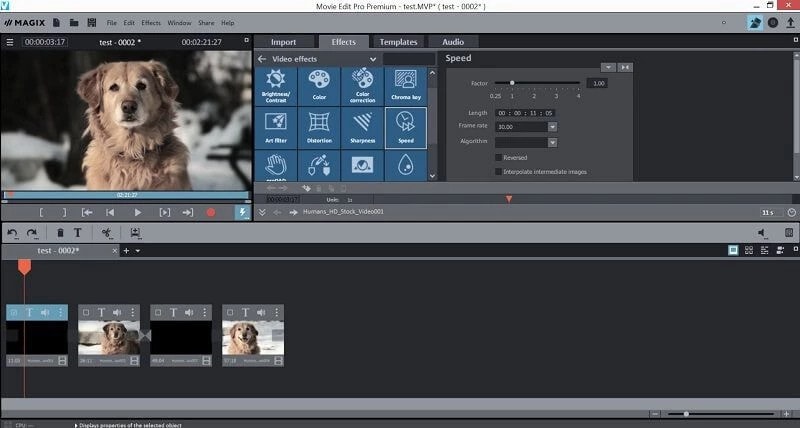
Key features
- NewBlue effects
- Fly-in animation
- New filter view
- Stabilization
- Motion tracking
- 8k support
Price
- Movie Studio 2024: $69.99 (30-day free trial)
- Movie Studio 2024 Platinum: $99.99 (30-day free trial)
- Movie Studio 2024 Suite: $129.00 (30-day free trial)
Pros
- Lots of video effects
- Responsive editing interface
- Multicam
- Trailer-like movie templates
- Solid audio editing
Cons
- Slower project rendering than others
- Lacks import and organization tools
Supported OS: Windows
PCMag Ratings: 3 stars out of 5
Summary
Magix movie studio is a powerful all-around video editing tool with many features that professional users have come to expect. It’s also relatively simple to use. But usability and performance are poor compared to other software programs like Filmora .
Part 4: How To Edit a Video With a Windows Movie Maker Alternative
Windows Movie Maker was great for editing a video, but it’s no match for some of the best video editing software. We’re talking about software capable of creating a cinematic experience in seconds, all on your computer.
When you need to edit a video with simple, quick edits, like adding a special effect or changing the background, try Filmora . Filmora is an easy-to-use application that allows you to create a movie using simple tools that don’t require additional training. You can’t beat this option if you want to create a professional-quality video for your blog or website.
Let’s dive into a quick tutorial on editing videos in Filmora:
Free Download For Win 7 or later(64-bit)
Free Download For macOS 10.14 or later
Step1 Open Wondershare Filmora on your PC or Mac
You can start a new project by clicking on ‘New Project’. And you can also change the ‘Aspect Ratio’ according to your project demand.

Step2 Import Videos
You can import your file by clicking the import tab on the upper-left side or clicking the import icon on the main window.
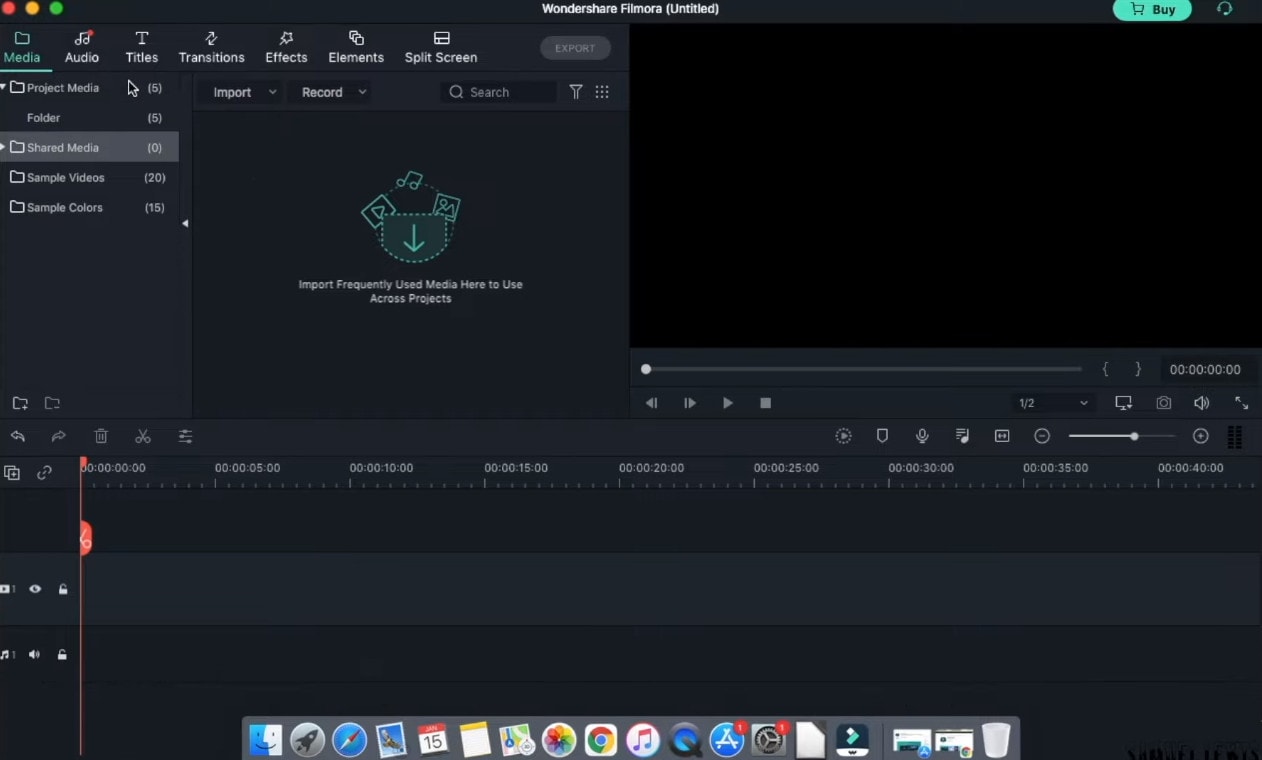
Step3 Drag and drop your footage to the timeline
After importing all the files, click and hold each individual video and drag and drop it to the timeline area according to your ideal sequence.
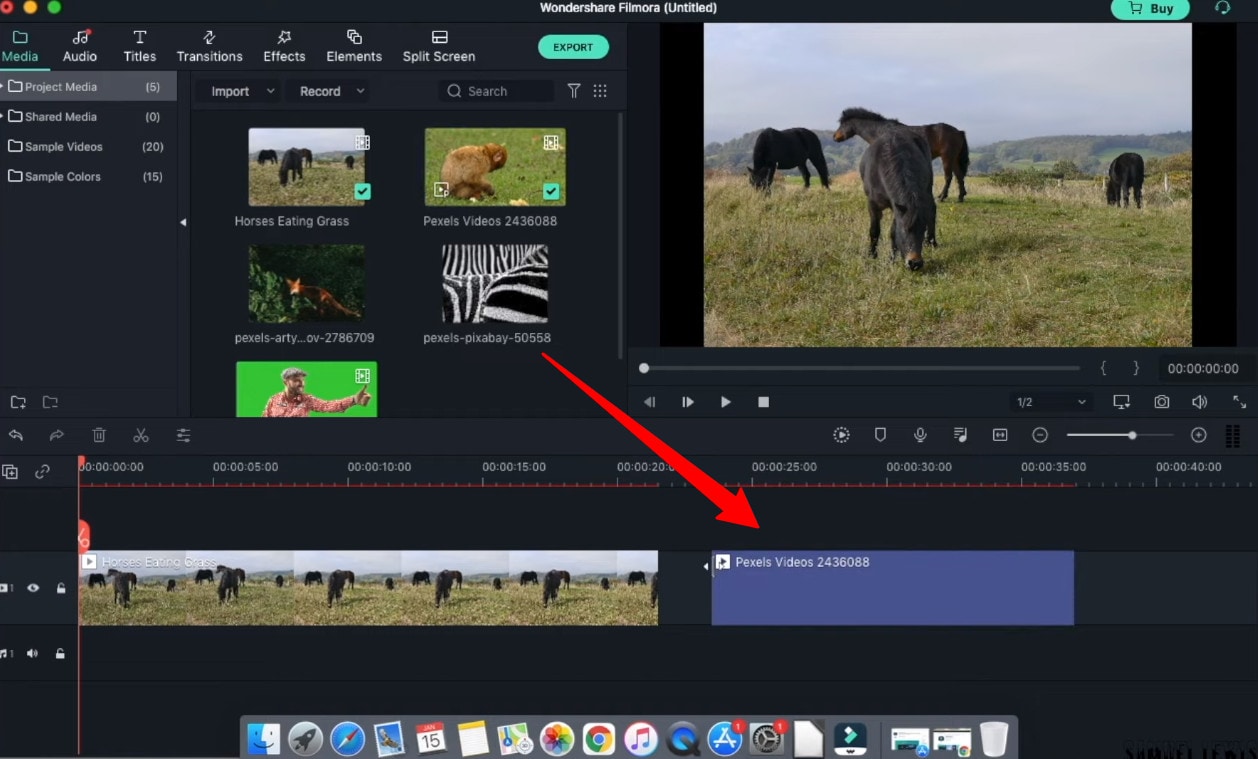
Step4 Add Audio
Go to the ‘Audio’ tab and select the audio file from the audio library. Once selected, drag and drop the audio file into the music timeline.
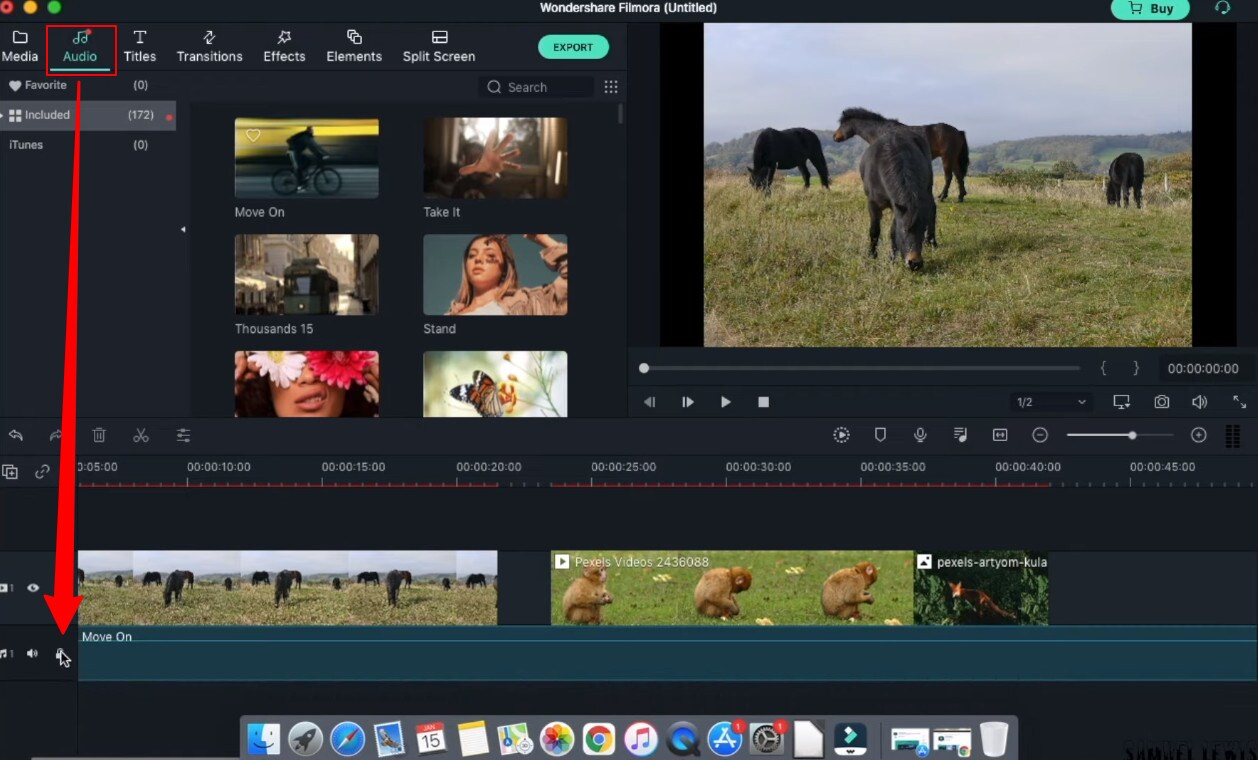
Step5 Add Titles
In your video intro, you can insert some title text. Go to the ‘Titles’ tab and select the one you like, and drag and drop it on top of the timeline. Double-click and edit the text and state your ideal statements. You can customize your text fonts and color too.
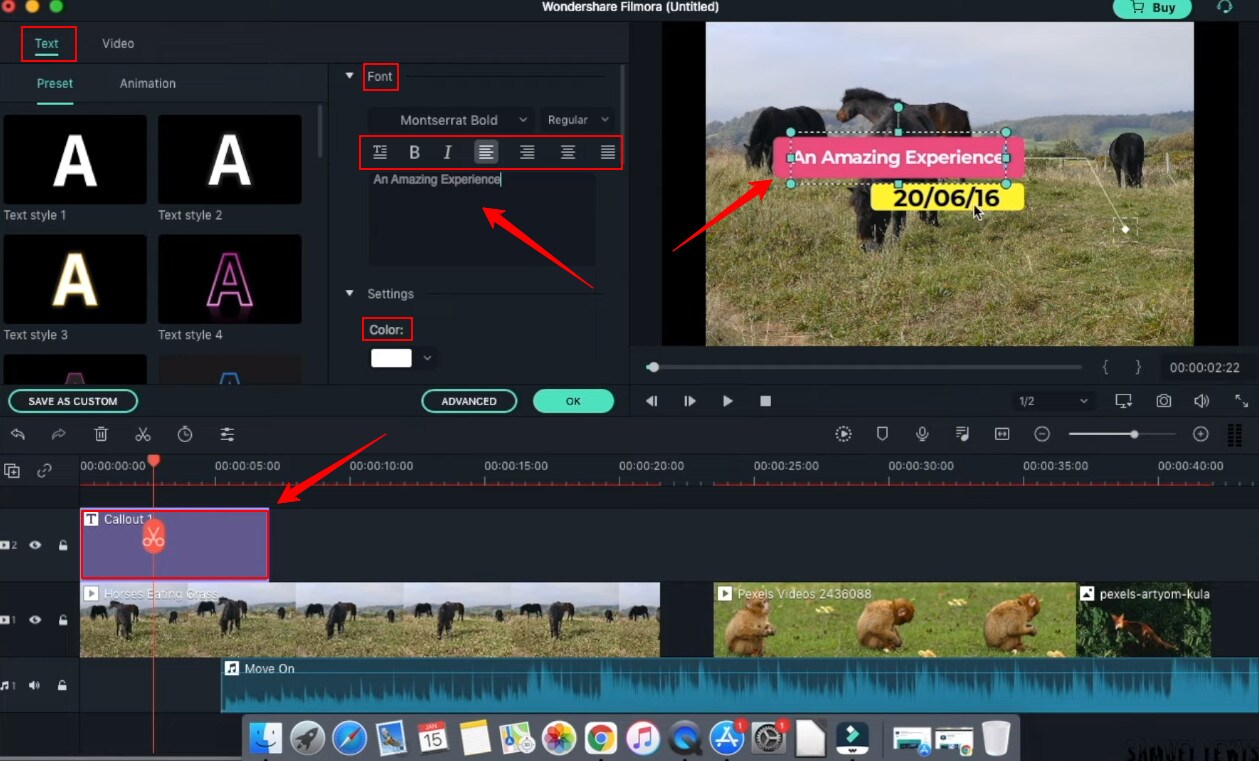
Step6 Add Transitions
You can add transition effects to ensure a smooth transition from one scene to another. The overall will get more professional look.

Step7 Add Effects
Next; you can get special effects to your video to make them more attractive and engaging to watch. Simple drag down the effect to your video and watch the effect take place in your selective scene.
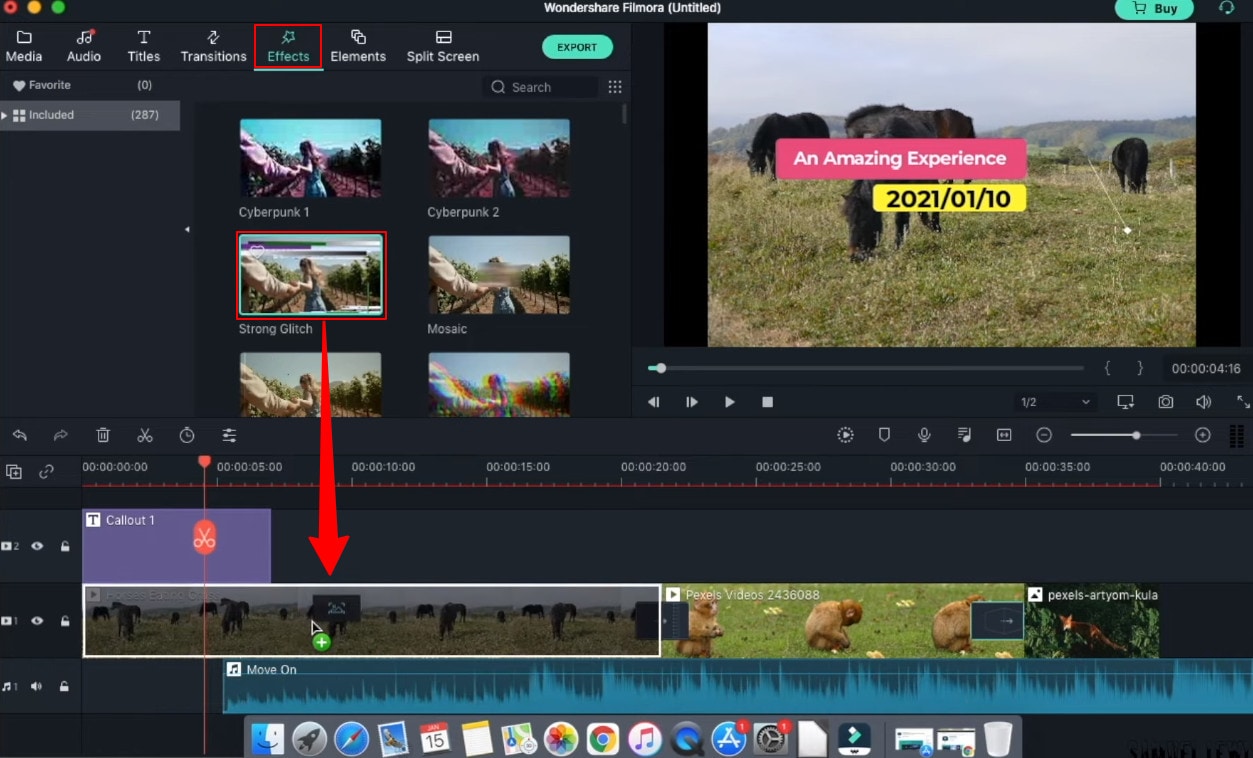
Step8 Export your work
Once all the changes have been made, hit ‘export’ from the top tab. A window will appear where you can change the settings, resolution, frame rate, bit rate, etc. Next, click the ‘export’ button down on that window, and then you can save the file in your drive.
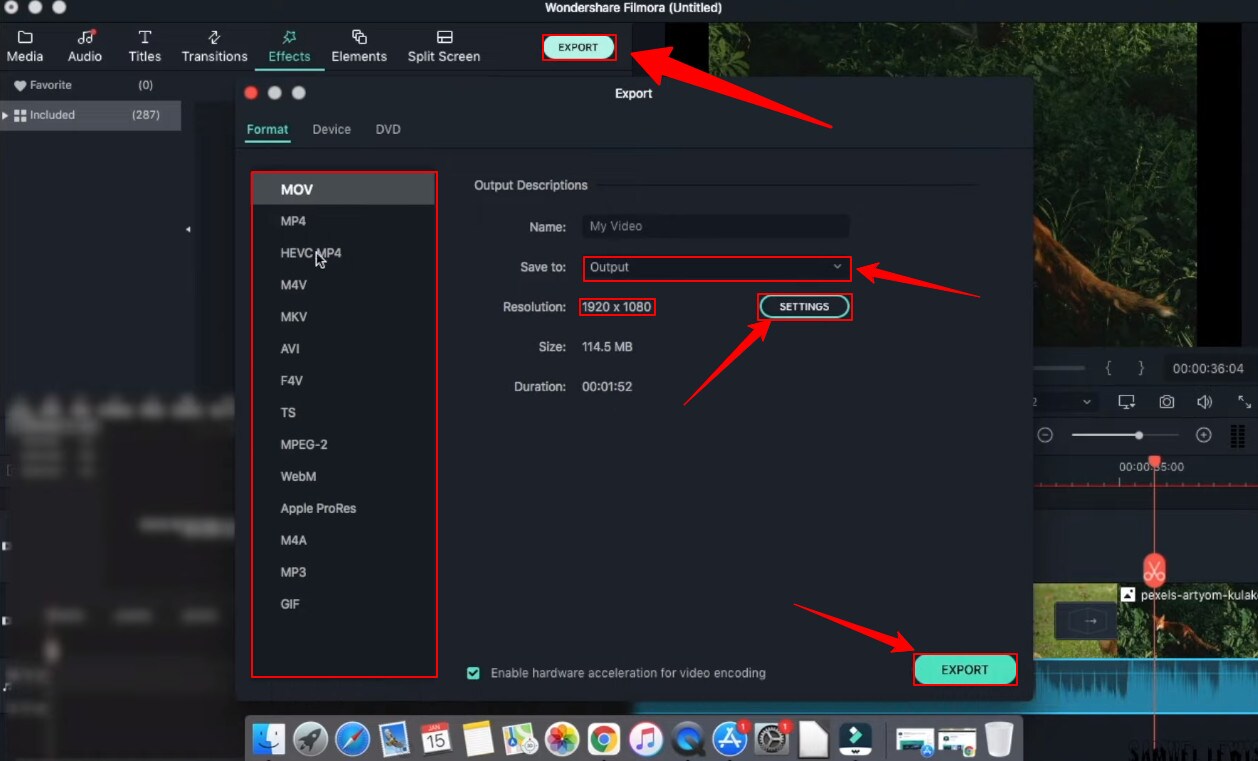
Part 5: Hot FAQs on Windows Movie Maker Alternatives
1. Why is Windows Movie Maker discontinued?
Microsoft’s video editing program, Windows Movie Maker, did not become a big hit with the public because it failed to do well on the market. Microsoft couldn’t get the support they were looking for from the program’s users. As a result, Microsoft had to cease its support of the program.
2. Is there a free version of Windows Movie Maker?
Microsoft Windows Movie maker was always accessible and pre-installed every windows product. Microsoft has discontinued support for Movie Maker and warns about free downloads of Movie Maker provided by third parties that might contain malware, viruses, or other issues.
3. What are the best free Windows Movie Maker Alternatives for Mac?
After switching to a Mac, you’ll find that the Windows Movie Maker alternatives offer much more than just a simple video editor. They provide advanced features, easy transitions, and less technical know-how to create pro-quality results. You should try using these platforms on your Mac if you have a video to edit.
- Wondershare Filmora
- Movavi
- OpenShot
Final Words
Windows Movie Maker is an excellent Windows video editor application for Windows users. But in recent years, it has become outdated due to the continuous development of new technologies. There are many alternatives for Windows Movie Maker, and here we listed some of the best ones. Most of them are free and featured packs. Each program has its unique set of features and capabilities, and each one excels in different areas. Check them out and see what you think.
Free Download For Win 7 or later(64-bit)
Free Download For macOS 10.14 or later
Part 1: Top 3 Picks for Windows Movie Maker Alternatives
The world’s best video editing software is about to change. We look at three of the most popular and valuable alternatives to Windows Movie Maker.
You will need to consider these alternatives to ensure they meet your expectations and needs.
1. Wondershare Filmora - Best Overall

Filmora is the best Windows Movie Maker Alternative designed according to your convenience.
Ratings: 4.4 Stars out 5
Starting from $49.99
2. Magix Movie Studio - Best for Collages

This alternative offers a variety of tools and plugins for anyone who wants to create professional-level videos in under a minute.
Download on Windows
Ratings: 4 stars out of 5
30-day free trials, then starts from $69.99 all the way to $129
3. Avidemux Video Editor - Best Open-Source Editor

An open-source editor that supports a wide range of formats is free! Avidemux has an interface similar to Windows Movie Maker, which makes it a perfect alternative.
Download on Windows
Ratings: 4.0 stars out of 5
Free Trial
Part 2: Ultimate Overview on 13 Best Alternatives to Windows Movie Maker
We live in visual culture, and we constantly see, capture, upload, and share videos on our smartphones, tablets, and laptops. So, it is only natural that more people seek ways to edit their videos. Windows Movie Maker was one of the most popular video editing apps. So it’s time to dig into the best Windows Movie Maker alternatives, which are arguably better and feature-rich.
| Software | OS | Media Resources | AI editing | Easy to Use | Free Trial |
|---|---|---|---|---|---|
| Wondershare Filmora | WindowsMacMobile | Yes | Yes | Yes | Yes |
| Avidemux | WindowsOS XLinuxBSD | Yes | No | Yes | Yes |
| Virtual Dub | Windows | No | No | Yes | Yes |
| Vegas Movie Studio | Windows | Yes | Yes | No | No |
| WeVideo | Online | Yes | No | Yes | Yes |
| Lightworks | LinuxOS X Windows | Yes | Yes | No | No |
| ShotCut | WindowsMacLinuxBSD | Yes | No | No | Yes |
| OpenShot | WindowsMacLinuxChrome OS | Yes | No | Yes | Yes |
| Movavi Plus | WindowsMac | Yes | No | Yes | Yes |
| VSDC | Windows | Yes | No | Yes | Yes |
| VideoPad | WindowsMaciPad/iPhone | Yes | No | Yes | Yes |
| HitFilm | WindowsMac | Yes | Yes | Yes | Yes |
| Magix Movie Studio | Windows | Yes | Yes | No | Yes |
Part 3: 13 Best Windows Movie Maker Alternatives for Windows
As we all know, Windows Movie Maker is the most used and trusted tool for creating videos in Windows. With its unique features and user-friendly interface, people often use this software to develop short and entertaining videos.
However, the fact is that Windows Movie Maker is not the current best video editing software for creating complex video projects. For this reason, we compiled a list of the 12 best alternatives to offer you a better option for Windows Movie Maker.
1. Wondershare Filmora
Filmora 11 is a powerful, easy-to-use video editor specially designed to streamline your workflow and save you hours weekly. It supports everything from Windows, Mac, and IOS to Android. The latest update to the flagship app includes several key enhancements that result in a much more efficient video creation workflow and one that’s easier to use than its rivals.

Key features
- Preset Templates
- Instant Mode
- Motion Tracking
- AI Editing Effects
- Auto Synchronization
- Plug-ins
Price
- Annual Plan: $49.99
- Perpetual Plan: $79.99
Pros
- Seamless interface for beginners
- Great customer support
- Plenty of effects and preset templates
- 4K video output options
Cons
- Rendering requires too much time
- The mobile app requires separate subscription
Supported OS: Windows , Mac , iOS , Android , iPad
G2 Ratings: 4.4 stars out of 5
Summary
Filmora’s intuitive interface allows experienced and brand-new users to create incredible videos with flawless special effects. Its high ratings and multiple supported formats make it quite popular among users.
2. Avidemux Video Editor
If you are a beginner and want to use a free, open-source software program for basic video editing, then Avidemux is a good choice. The interface is not as fancy as it could be, but there are some presets that’ll save you a lot of time. Avidemux is a cross-platform video editor that allows you to create custom videos, but it doesn’t feature the ability to share the edited footage to social media directly,

Key features
- Video and Audio Filters
- Support Popular Formats
- Convert Video For Archiving or Publishing
Price: Free
Pros
- It can convert Video To A Smaller Size
- Easy cut, trim, split video
Cons
- Out-dated UI
- Lacks sharing option
Supported OS: Windows , OS X , Linux , BSD
Uptodown Ratings: 4.0 stars out of 5
Summary
An open-source video editor that supports most formats. Due to its obsolete UI and lack of sharing features, Avidemux has average ratings.
3. VirtualDub
This open-source software is user-friendly and allows users with little experience to navigate the software without much trouble. It supports 3rd party apps and also offers batch-processing, which means working on multiple videos simultaneously makes it possible.

Key features
- Integrated volume and histogram meter
- Optimized disk
- Noise reduction
- Fractional frame rates
Price: Free
Pros
- Clean interface, easy to use
- Keyboard and mouse shortcuts for faster operation
- Free to use
Cons
- Not suitable for 4K editing
- Lack learning material
- Obsolete Interface
Supported OS: Windows
Compare Camp Ratings: 4.0 stars out of 5
Summary
Virtual Dub supports multitasking, and its features are pretty helpful. However, it lacks 4k editing and a friendly interface. Overall Virtual Dub is a good choice.
4. Sony Vegas Movie Studio
This video editing software makes it easy to create professional-looking videos in minimum time and effort. Vegas Movie Studio software is best for video editing professionals who have been doing it for some time and are looking for something a little more sophisticated than free alternatives. Not only does it has a high retail price, but its internal elements can be too complex for those just beginning.

Key features
- Color correction
- HDV and AVCHD-editing
- DV batch capture
- Wide variety of file formats and codecs
Price: Starting from $7.99 USD per month
Pros
- Customizable interface
- Multicam editing
- Lots of effects and transitions, with plug-in capability
- Good slow motion and warp flow transition tools
Cons
- Less intuitive interface than competitors
- Import from camcorder not ideal
- Some tools are complex
Supported OS: Windows
G2 Ratings: 4.4 out of 5
Summary
Vegas Movie Studio is the choice of professionals. It does all the work without taking up a lot of resources, and like most programs, there is a learning curve. It’s not always intuitive for beginners, but its professional and powerful features score decent in most reviews.
5. WeVideo
This cloud-based application is a simple-to-use video editing and sharing suite. WeVideo is a full-featured video editing application that uses JumpStart technology to create amazing videos. It’s an innovative app that offers a seamless editing experience as it supports multiple formats of video, images, audio, and graphics.

Key features
- WeVideo JumpStart
- Cloud storage
- Built-in graphics
- Customizable environment
- Advanced text editing
- Multi-track editing and storyboard
Price
- Free trial
- Power Plan: $9.99/month
- Unlimited Plan: $15.99/month
- Professional Plan: $39.99/month
- Business Plan: $73.99/month
Pros
- Constantly improving features
- Ease of use
- Storage is cloud-based
Cons
- Old fashion transition
- Leaves a watermark on free trial
Supported OS: Online
Trustpilot Ratings: 4 stars out of 5
Summary
WeVideo is a straightforward yet robust video editor. It offers a variety of features and supports multiple formats, plus its comprehensive pricing plan makes it useful for everyone.
6. Lightworks
Lightworks is the most powerful video editor in its class and an excellent tool for professionals who want to make amazing videos quickly. Lightworks is very fast and straightforward to use, and it has some great features you won’t find in any other video editor. It is available on all popular OS.

Key features
- Audio and Video Effect Plugin Support
- Cloud Connected
- Motion Graphics
- Advanced Metadata
- Proxy Workflows
- Apple ProRes decoding
Price
- Monthly Plan: $9.99/user
- Yearly Plan: $9.99/user
- Perpetual: $154.99
Pros
- High-resolution timeline rendering
- It has social media export templates
- Interfaces for multiple OS are consistent
- Instant autosave
Cons
- Commands are not always intuitive
- A bit pricey as compared to its competitors
Supported OS: Windows , Mac , Linux
Techradar Pro Ratings: 4 stars out of 5
Summary
Lightworks is not any other video editing tool available on the market of video editing tools. This video editing tool provides amateurs with the most sophisticated features in an optimized platform. Its scores are the highest on almost every review site.
7. ShotCut
Shotcut is a multiplatform video editor that lets you work with various formats for audio, video, image files, etc. This video editor makes it easy to mix and match the resolution and frame rates in a video file. All the changes you make in the editor can be undone and redone often. Shotcut is the best choice for video editing, without question.

Key features
- Webcam capture
- Audio scopes and filters
- Deinterlacing
- Eyedropper tool
- Video wipe transitions
- Keyframes for filter parameters
Price: Free
Pros
- Support for 4K resolutions
- Free
Cons
- Less intuitive than commercial apps
- Lacks built-in sharing to popular sites
Supported OS: Windows , Mac , Linux
GetApp Ratings: 4.5 out of 5 stars
Summary
Shotcut is an open-source video editor for creative professionals and is available on mac, Windows, and Linux. The free version of Shotcut has many excellent features, but it doesn’t have the slick interface or advanced techniques of the top paid editors.
8. OpenShot
An award-winning open-source video editor that creates stunning videos. OpenShot is a fast, easy-to-use, and surprisingly powerful video editor. OpenShot Video Editor allows you to work with many different types of tracks so that your edits will seem natural. OpenShot Video Editor allows you to add your custom animations or titles. The options are endless, so it all depends on your time and interest. It is available in more than 70 languages, making it ideal for all types of users.

Key features
- 3D animations
- Animation and keyframes
- Multiple languages and formats
- Cross-platform
- Video-effects
Price: Free
Pros
- It is a non-linear editor with infinite tracks
- 100% free without watermark
- Frequent updates
Cons
- Obsolete interface
- Unstable performance
- Lacks some editing features
Supported OS: Window , Mac , Linux , Chrome OS
Getapp Ratings: 4.2 stars out of 5
Summary
Another open-source video-editor in the list is named OpenShot. It’s a multi-lingual and multi-supported app with unique features. Despite its unstable performance, OpenShot is still an ideal choice for many users.
9. Movavi Video Editor Plus
Movavi Video Editor Plus is the perfect tool to bring your creative ideas to life. It has special effects, ready-made intros, and keyframe animation. Using chroma keying, you can change the background of your video clips to any color or pattern that suits your need. Movavi has now redesigned its user interface to make it easy to use.

Key features
- Effects and transitions
- Built-in media pack
- Fast processing of 4K videos
- Keyframe animation
- Automatic video creation
- Cutting, trimming, joining
Price
- Free version: 7 days
- Video Editor Plus 1 year /1 PC: $49.95
- Video Editor Plus Lifetime /1 PC: $69.95
- Video Suite Lifetime /1 PC: $89.95
Pros
- Easy-to-understand user interface
- Transitions with sound
- Motion tracking and picture-in-picture tools
- Chroma-key capability
- Quick movie-creation tool
Cons
- Lacks advanced trim modes
- Slow rendering
PCMag Ratings: 4.0 stars out of 5
Summary
If you want to edit your videos with a minimal learning curve, try Movavi. You get PiP, chroma-keying, titling, basic keying, and motion tracking. The program is simple to use but doesn’t have all the features and stands four stars.
10. VSDC Free Video Editor
VSDC Free Video Editor is an online tool that lets you edit audio and video files to make your creations like movies, YouTube tutorial videos, and more. The audio and video files supported are extensive, and the software includes a codec manager. The Pro version isn’t necessary if you’re using the free edition of the software; it’s more than enough to get the job done.

Key features
- Dark theme
- Subpixel Accuracy
- Powerful Chroma Key tool
- Trendy video effects, filters, and transitions
- Color Blending And Filters
- Built-In DVD Burning Tool
Price: Free
Pros
- Non-linear
- Video effects library
- Video stabilization
- Masking
Cons
- Outdated interface
- Lack keyboard shortcuts
- Only available on Windows
Supported OS: Windows
Capterra Ratings: 4.5 stars out 5
Summary
VSDC is a non-linear editor with extensive format support. It includes all the essential features an editor requires but with an obsolete UI. It is also ideal for many who need a powerful yet free video editor.
11. VideoPad Video Editor
VideoPad is a free video editor that can create stunning videos and perform basic editing tasks. A good video editor can help you to create videos for different social media platforms. You can make your videos look professional and polished with a few clicks and some simple editing skills. There’s nothing particularly exciting or advanced about this app; it’s simple enough for anyone new to video editing or even for seasoned editors. But the simple and easy-to-use interface makes the entire process very exciting.

Key features
- Text snippets
- Range of transitional effects
- Plug-ins Library
- Burn finished videos to Blu-Ray, DVD, etc.
- Color correction and light balance.
Price: Free
Pros
- Simple and clean interface
- Supports multiple file formats
- Includes video effects
- Lightweight on system resources
Cons
- Lack of advanced features
Supported OS: Windows , Mac , iPad/iPhone
Tom’s guide Ratings: 3.5 stars out of 5
Summary
Video pad is a free video editor designed for beginners that is lightweight and simple. VideoPad is also great for creating quick videos for social media purposes like Youtube and Facebook. The software has a high rating, as shown above, and it’s available on Windows.
12. HitFilm
HitFilm is a helpful video editing software that makes editing easier for users. In addition to basic features, the program also provides advanced-level functions that make edited videos pop. Hitfilm Express Download has more than 400 features to help casual video editors save time. Features like: visual effects, cinematic elements, and compositing tools preset help unleash your creativity.

Key features
- Color Grading and correction
- Smart search
- Commentator recorder
- Lightning and lens flares
- 3D camera tracker
Price
- Free trial
- Creator: $7.50
- Pro: $12.50
- Enterprise: Custom pricing
Pros
- Intuitive interface
- It offers free tutorials and masterclasses
- Works on both Windows and Mac
Cons
- It requires heavy system requirements
TechRadar Ratings: 4.5 stars out of 5
Summary
HitFilm Express 15 is a powerful free video editing program that enables you to create high-quality videos in minutes with an intuitive interface. It offers advanced editing features such as advanced video trimming, 3D editing, and more.
13. Magix Movie Studio
Magix is the world’s leading professional audiovisual media software, with Sequoia being its industry-standard audio editing software. This movie editor is an enthusiast-level video editing software that competes with software from Adobe and CyberLink, and it even boasts support for 4K content and 360 degrees. There are many reasons to upgrade. This year’s update includes stabilization, 8K editing, motion tracking, and an in-app plug-in store.

Key features
- NewBlue effects
- Fly-in animation
- New filter view
- Stabilization
- Motion tracking
- 8k support
Price
- Movie Studio 2024: $69.99 (30-day free trial)
- Movie Studio 2024 Platinum: $99.99 (30-day free trial)
- Movie Studio 2024 Suite: $129.00 (30-day free trial)
Pros
- Lots of video effects
- Responsive editing interface
- Multicam
- Trailer-like movie templates
- Solid audio editing
Cons
- Slower project rendering than others
- Lacks import and organization tools
Supported OS: Windows
PCMag Ratings: 3 stars out of 5
Summary
Magix movie studio is a powerful all-around video editing tool with many features that professional users have come to expect. It’s also relatively simple to use. But usability and performance are poor compared to other software programs like Filmora .
Part 4: How To Edit a Video With a Windows Movie Maker Alternative
Windows Movie Maker was great for editing a video, but it’s no match for some of the best video editing software. We’re talking about software capable of creating a cinematic experience in seconds, all on your computer.
When you need to edit a video with simple, quick edits, like adding a special effect or changing the background, try Filmora . Filmora is an easy-to-use application that allows you to create a movie using simple tools that don’t require additional training. You can’t beat this option if you want to create a professional-quality video for your blog or website.
Let’s dive into a quick tutorial on editing videos in Filmora:
Free Download For Win 7 or later(64-bit)
Free Download For macOS 10.14 or later
Step1 Open Wondershare Filmora on your PC or Mac
You can start a new project by clicking on ‘New Project’. And you can also change the ‘Aspect Ratio’ according to your project demand.

Step2 Import Videos
You can import your file by clicking the import tab on the upper-left side or clicking the import icon on the main window.

Step3 Drag and drop your footage to the timeline
After importing all the files, click and hold each individual video and drag and drop it to the timeline area according to your ideal sequence.

Step4 Add Audio
Go to the ‘Audio’ tab and select the audio file from the audio library. Once selected, drag and drop the audio file into the music timeline.

Step5 Add Titles
In your video intro, you can insert some title text. Go to the ‘Titles’ tab and select the one you like, and drag and drop it on top of the timeline. Double-click and edit the text and state your ideal statements. You can customize your text fonts and color too.

Step6 Add Transitions
You can add transition effects to ensure a smooth transition from one scene to another. The overall will get more professional look.

Step7 Add Effects
Next; you can get special effects to your video to make them more attractive and engaging to watch. Simple drag down the effect to your video and watch the effect take place in your selective scene.

Step8 Export your work
Once all the changes have been made, hit ‘export’ from the top tab. A window will appear where you can change the settings, resolution, frame rate, bit rate, etc. Next, click the ‘export’ button down on that window, and then you can save the file in your drive.

Part 5: Hot FAQs on Windows Movie Maker Alternatives
1. Why is Windows Movie Maker discontinued?
Microsoft’s video editing program, Windows Movie Maker, did not become a big hit with the public because it failed to do well on the market. Microsoft couldn’t get the support they were looking for from the program’s users. As a result, Microsoft had to cease its support of the program.
2. Is there a free version of Windows Movie Maker?
Microsoft Windows Movie maker was always accessible and pre-installed every windows product. Microsoft has discontinued support for Movie Maker and warns about free downloads of Movie Maker provided by third parties that might contain malware, viruses, or other issues.
3. What are the best free Windows Movie Maker Alternatives for Mac?
After switching to a Mac, you’ll find that the Windows Movie Maker alternatives offer much more than just a simple video editor. They provide advanced features, easy transitions, and less technical know-how to create pro-quality results. You should try using these platforms on your Mac if you have a video to edit.
- Wondershare Filmora
- Movavi
- OpenShot
Final Words
Windows Movie Maker is an excellent Windows video editor application for Windows users. But in recent years, it has become outdated due to the continuous development of new technologies. There are many alternatives for Windows Movie Maker, and here we listed some of the best ones. Most of them are free and featured packs. Each program has its unique set of features and capabilities, and each one excels in different areas. Check them out and see what you think.
Free Download For Win 7 or later(64-bit)
Free Download For macOS 10.14 or later
AI-Powered Video Editing Software for Easy Reframing
The auto-frame feature is needed to edit the videos professionally. Its purpose is to adjust the video clips so that the action of a scene is never out of the frame even after reformatting the video. Specifically, the quality of your video is not affected, and no frame is lost or damaged when you reformat the video for different aspect ratios.
The smart auto-reframe feature is mainly used for posting videos on social media platforms such as Facebook, Instagram, YouTube, etc. This article provides you with detailed information about the best video editors that are enriched with the smart auto-reframe feature. The method of using these tools is also provided.
Top Video Editors with Auto-Reframe for Smart Crop
Following are some of the best video editors that consist of an auto-reframe feature for smart crop:
1. Wondershare Filmora Video Editor
Supported OS: Windows and macOS
Pricing: Free trial, $ 79.99 for perpetual plan
For Win 7 or later (64-bit)
For macOS 10.12 or later
Wondershare Filmora Video Editor is a powerful and easy video editing software that provides different methods to save and share the video. This software includes GIF support, 4K editing support, and an audio equalizer. You can remove background noise from the video. Its key features also include video stabilization , color tuning, scene detection, advanced text editor and audio mixer,
Wondershare Filmora comes with plenty of smart features, among which auto-reframe is top of the list. It saves your editing time to create or edit a professional video. This feature can detect a moving object in your video and crops it automatically to suit different aspect ratios so you can post it on various platforms. In this way, it enhances the efficiency of your video. To use the auto-reframe feature in Filmora, you can follow the steps below:
Step 1: Install and Launch Software
Download the software and launch it on your devices. From Tools, select Auto Reframe.
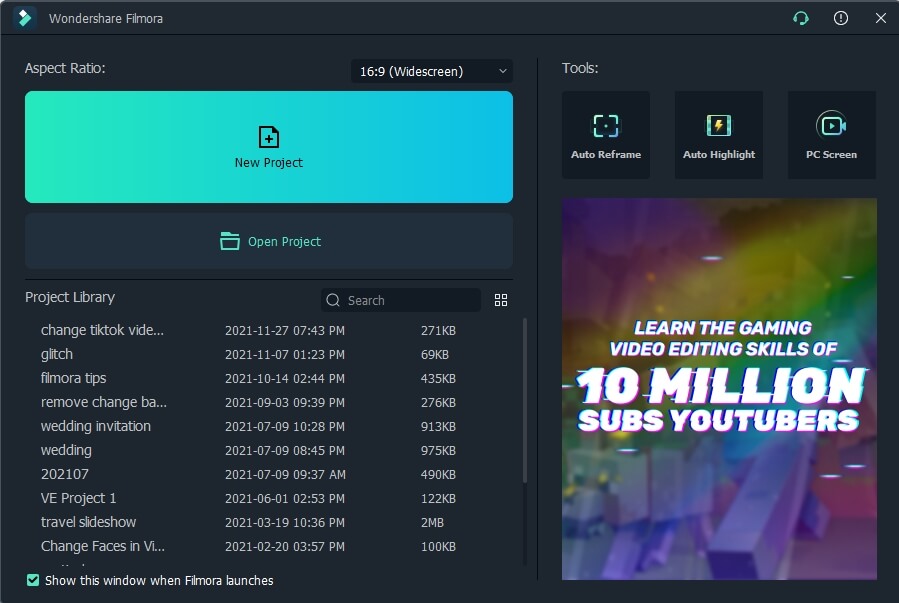
Step 2: Import File
Use the drag and drop feature to import the file or click on the Import button for selecting and importing it.
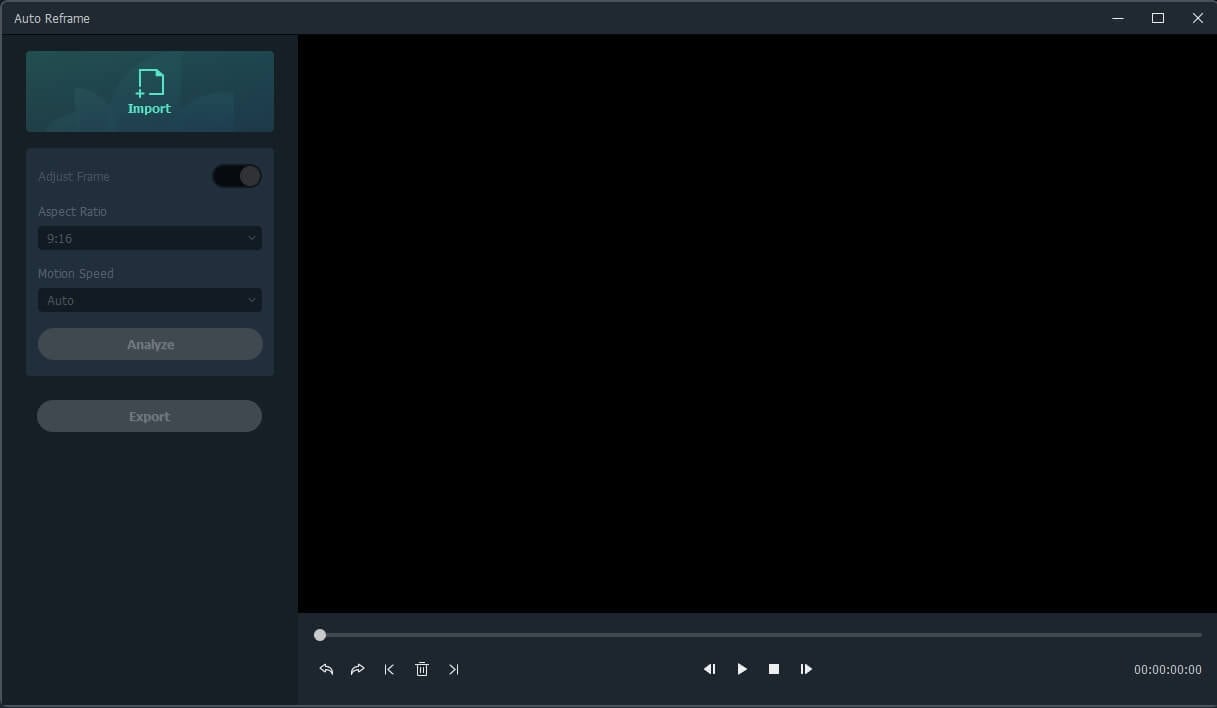
Step 3: Choose Aspect Ratio
To start reframing, select the aspect ratio you need. You can also define the motion speed of the reframed video clip to make it fast or slow or keep the original speed. And then click Analyze to apply changes. Here I will choose 9:16 portrait mode to take the example.
Step 4: Adjust Frame
Filmora will convert the video to the selected aspect ratio automatically. After analyzing, select the frame and adjust its position.
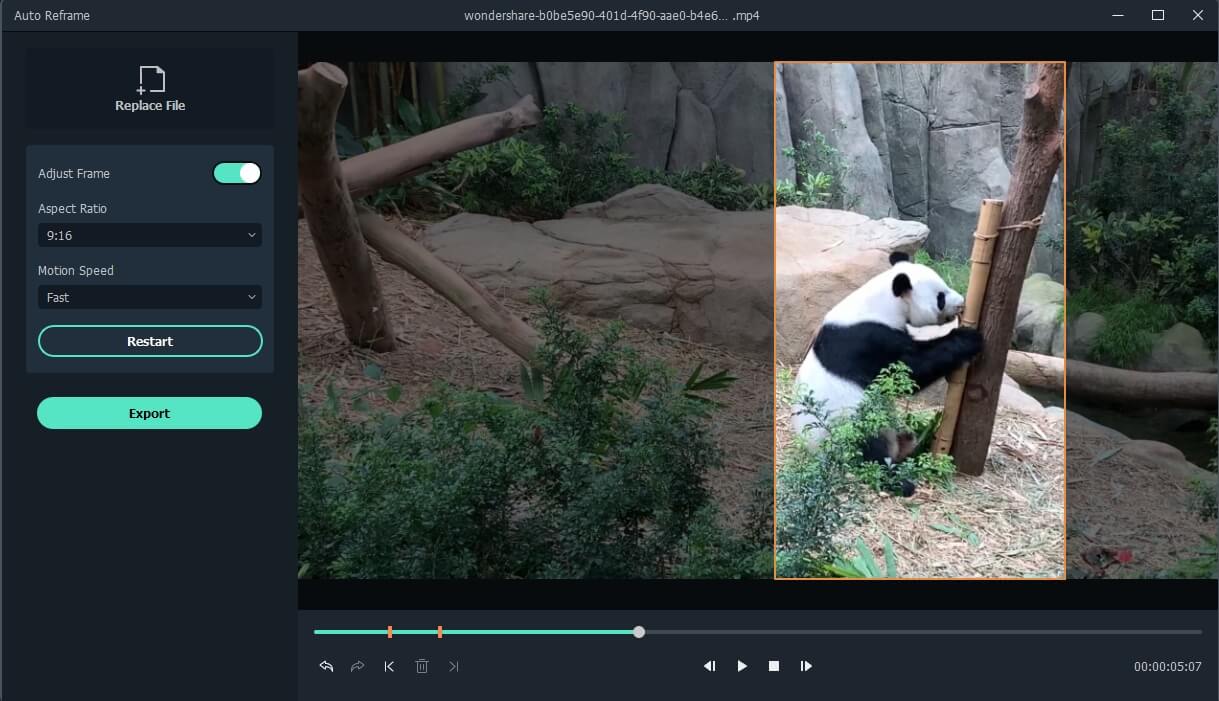
Step 4: Export File
Click the Export button to save the file when you are done with reframing, adjustment, and editing. Share it where you want to.
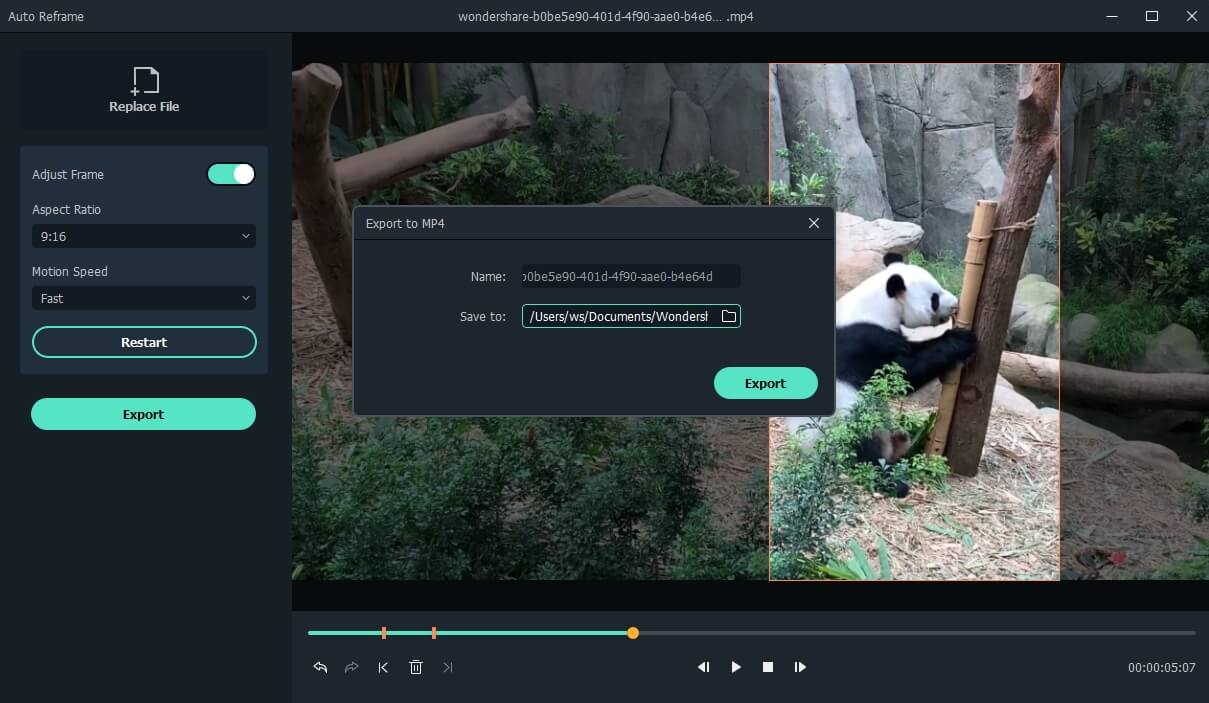
2. Adobe Premiere Rush
Supported OS: Android, iOS, Windows and macOS
Pricing: Free trial, $9.99 per month
Adobe Premiere Rush is a desktop and mobile video editing app that lets you create innovative videos from your computer or mobile phone. It enables you to control your creations with audio features and graphic templates. It allows you to capture, color-correct, change clip sequence, trim, add color filters, text overlays, and record voiceovers .
The feature of auto-reframe is also available in this software that allows you to adjust your video and do reframing. You can set the frames according to your needs and requirements through the application of Auto Reframe to your video without affecting its quality when uploaded on social media platforms.
Step 1: Download the Software
Download the software on your mobile or computer and launch it.
Step 2: Import a Video
Import a video to the software you want to edit and adjust its frames.
Step 3: Apply Auto Frame
Click Effects panel and then select Auto Reframe, which will automatically keep the most important parts of the shot in the frame, and then the process will be started.
Step 4: Adjust Frames and Add Effects
Click Adjust Frame to adjust frame size according to your needs. To add Pan and Zoom effects or other effects, click Effects, select Motion menu.
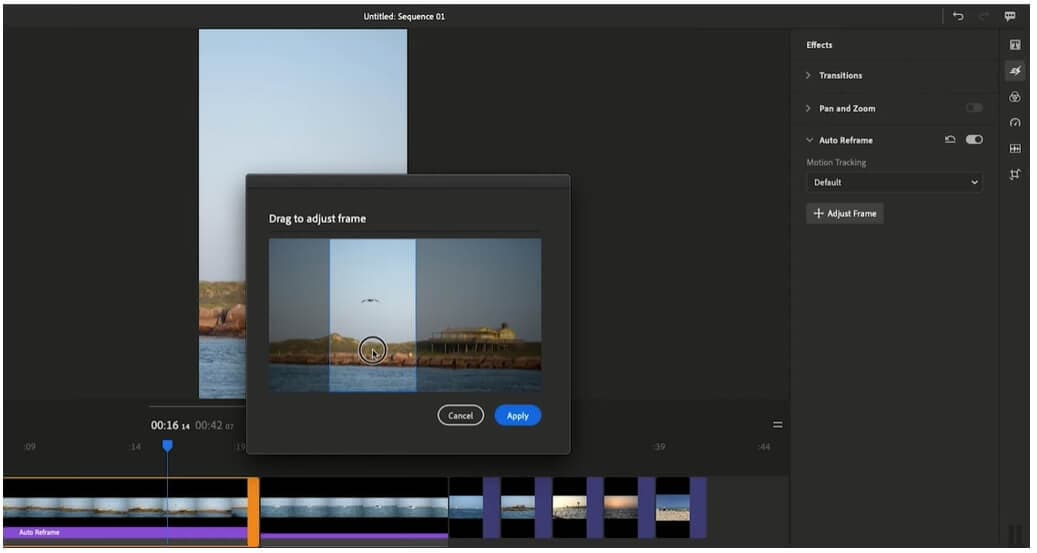
Step 4: Adjust and Export
Set the speed of the video and the clip duration, and then export your video when editing is done. Save it to your device and share it.
3. Adobe Premiere Pro
Supported OS: Windows and macOS
Pricing: $20.99 per month (annual plan monthly paid)
Adobe Premiere Pro is a video editing software that is flexible and efficient for professional videos. It consists of powerful creative tools for audio, graphics, and colors. It allows you to create simultaneous projects and use motion graphic templates to enhance your video. This software also provides the feature of VR audio editing, transitions, adding effects, etc.
Adobe has added the smart auto-reframe feature to the software, especially for the broadcasters to optimize their content for different social media platforms. Using the auto-reframe feature, they can edit video in both YouTube’s landscape interface and Instagram’s vertical format.
Step 1: Download and Launch Software
Download the software from its official website, install it and launch it to use.
Step 2: Select the Sequence
Right-click and select the Auto Reframe Sequence option. Click New Item and select Sequence to create a sequence or add an already shot sequence.
Step 3: Apply Auto Reframe Feature
Select Effects and double click Auto Reframe tab to apply its effects. Select Aspect Ratio for reframing the video.
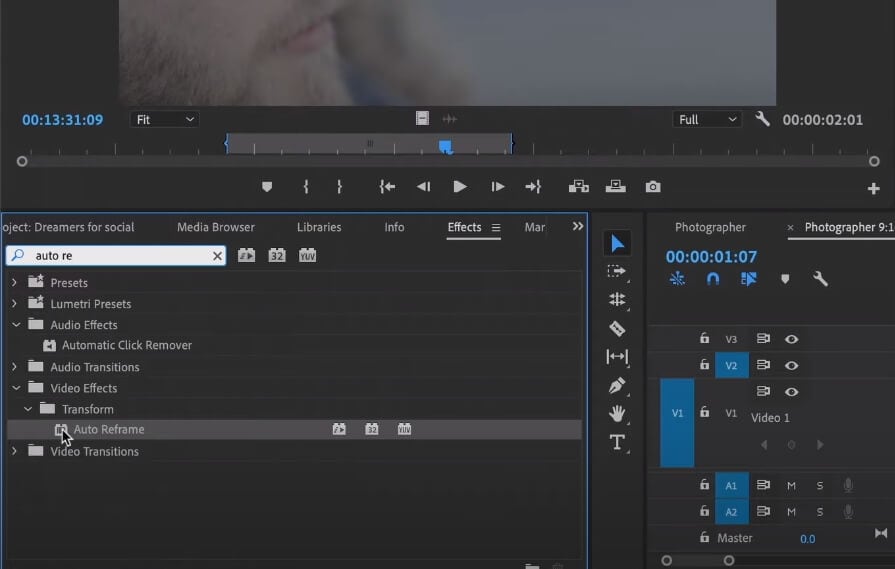
Step 4: Export and Save
Export the file when the auto frame feature is applied. Save it and share it.
4. Final Cut Pro X
Supported OS: Mac OS
Pricing: Free trial, $299.99
Final Cut Pro X was developed by Apple. It is a video editing software that allows you to edit a simple video to a traditional one because it consists of the Object Tracker for adding dynamic text to the video.
You can also add colors to the moving footage. You can apply tracking data to other graphics and text files to enhance your work.
The smart auto-frame feature present in Final Cut Pro X allows you to adjust the aspect ratios of the video file. Smart Conform feature will enable you to Auto Reframe in this Apple’s software where it works on sequences.
Step 1: Download and Install Software
Download Final Cut Pro X from its official website, install and launch it.
Step 2: Create Project
Create a project with the aspect ratio you need, i.e., vertical, landscape, square, etc, and click Smart Conform to apply Auto Reframe, and then set frame size and set the aspect ratio to maximize image quality. In this way, Final Cut Pro will analyze all the clips, focus on the most interesting parts, and automatically conform each clip to fill the entire frame.
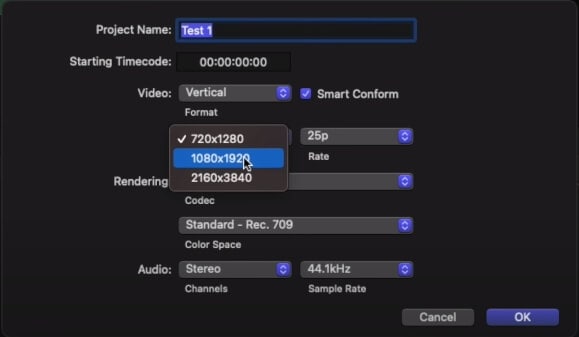
Step 3: Add File and Adjust
Add file to the timeline, and you will the video is auto reframed in the Preview window. You can skim through the project to check how the Smart Conform tool did on the rest of the clips.
If you find some frames are out of the edge, you can manually adjust its position with keyframing.
Step 4: Save File
After everything is finely adjusted, export the edited and adjusted video and save it to your device.
5. Kamua
Supported OS: Online tool available for all devices
Pricing: Free
Kamua is a video editing browser-based tool that does not require to be downloaded. It comes with a user-friendly interface that makes it easy to use and understand. You can add subtitles to your video using this tool. It allows you to add filters to your video to make it effective and gain the attention of your followers. Its Ai features let you crop the video efficiently.
You can change the dimensions of the video and aspect ratio from vertical to horizontal using the Auto Reframe feature. In this software, the Auto Reframe feature is enabled by the AutoCrop feature that allows you to resize and reframe your video or the clips that have movement.
Step 1: Visit the Official Website
Open the official website of Kamua to use it for reframing: https://kamua.com/ .
Step 2: Select Aspect Ratio
Open Crop Settings and set the Aspect ratio for your file
Step 3: Apply Feature
Toggle AutoCrop and click Generate AutoCrop Preview. Set the aspect ratio and video dimensions
Step 4: Export File
Export the edited file when you are done with the reframing and resizing step. Save the file and share it to your desired platform.
Note: Since 16 November, 2021, Kamua is part of Jellysmack and the services has been discontinued. If you didn’t register it before, you may can’t use the features mentioned above.
Conclusion
The modern video editing software comes with the feature of smart auto reframing. This feature allows you to upload your video according to the platform where you want to upload it. For example, if you need to upload a video on YouTube, you can set the aspect ratio in the landscape interface. And if you want to upload your video on Instagram, you can set the aspect ratio to vertical format. These tools also allow you to set video dimensions. They not only allow you to edit videos but also the images having motion.
For Win 7 or later (64-bit)
For macOS 10.12 or later
Wondershare Filmora Video Editor is a powerful and easy video editing software that provides different methods to save and share the video. This software includes GIF support, 4K editing support, and an audio equalizer. You can remove background noise from the video. Its key features also include video stabilization , color tuning, scene detection, advanced text editor and audio mixer,
Wondershare Filmora comes with plenty of smart features, among which auto-reframe is top of the list. It saves your editing time to create or edit a professional video. This feature can detect a moving object in your video and crops it automatically to suit different aspect ratios so you can post it on various platforms. In this way, it enhances the efficiency of your video. To use the auto-reframe feature in Filmora, you can follow the steps below:
Step 1: Install and Launch Software
Download the software and launch it on your devices. From Tools, select Auto Reframe.

Step 2: Import File
Use the drag and drop feature to import the file or click on the Import button for selecting and importing it.

Step 3: Choose Aspect Ratio
To start reframing, select the aspect ratio you need. You can also define the motion speed of the reframed video clip to make it fast or slow or keep the original speed. And then click Analyze to apply changes. Here I will choose 9:16 portrait mode to take the example.
Step 4: Adjust Frame
Filmora will convert the video to the selected aspect ratio automatically. After analyzing, select the frame and adjust its position.

Step 4: Export File
Click the Export button to save the file when you are done with reframing, adjustment, and editing. Share it where you want to.

2. Adobe Premiere Rush
Supported OS: Android, iOS, Windows and macOS
Pricing: Free trial, $9.99 per month
Adobe Premiere Rush is a desktop and mobile video editing app that lets you create innovative videos from your computer or mobile phone. It enables you to control your creations with audio features and graphic templates. It allows you to capture, color-correct, change clip sequence, trim, add color filters, text overlays, and record voiceovers .
The feature of auto-reframe is also available in this software that allows you to adjust your video and do reframing. You can set the frames according to your needs and requirements through the application of Auto Reframe to your video without affecting its quality when uploaded on social media platforms.
Step 1: Download the Software
Download the software on your mobile or computer and launch it.
Step 2: Import a Video
Import a video to the software you want to edit and adjust its frames.
Step 3: Apply Auto Frame
Click Effects panel and then select Auto Reframe, which will automatically keep the most important parts of the shot in the frame, and then the process will be started.
Step 4: Adjust Frames and Add Effects
Click Adjust Frame to adjust frame size according to your needs. To add Pan and Zoom effects or other effects, click Effects, select Motion menu.

Step 4: Adjust and Export
Set the speed of the video and the clip duration, and then export your video when editing is done. Save it to your device and share it.
3. Adobe Premiere Pro
Supported OS: Windows and macOS
Pricing: $20.99 per month (annual plan monthly paid)
Adobe Premiere Pro is a video editing software that is flexible and efficient for professional videos. It consists of powerful creative tools for audio, graphics, and colors. It allows you to create simultaneous projects and use motion graphic templates to enhance your video. This software also provides the feature of VR audio editing, transitions, adding effects, etc.
Adobe has added the smart auto-reframe feature to the software, especially for the broadcasters to optimize their content for different social media platforms. Using the auto-reframe feature, they can edit video in both YouTube’s landscape interface and Instagram’s vertical format.
Step 1: Download and Launch Software
Download the software from its official website, install it and launch it to use.
Step 2: Select the Sequence
Right-click and select the Auto Reframe Sequence option. Click New Item and select Sequence to create a sequence or add an already shot sequence.
Step 3: Apply Auto Reframe Feature
Select Effects and double click Auto Reframe tab to apply its effects. Select Aspect Ratio for reframing the video.

Step 4: Export and Save
Export the file when the auto frame feature is applied. Save it and share it.
4. Final Cut Pro X
Supported OS: Mac OS
Pricing: Free trial, $299.99
Final Cut Pro X was developed by Apple. It is a video editing software that allows you to edit a simple video to a traditional one because it consists of the Object Tracker for adding dynamic text to the video.
You can also add colors to the moving footage. You can apply tracking data to other graphics and text files to enhance your work.
The smart auto-frame feature present in Final Cut Pro X allows you to adjust the aspect ratios of the video file. Smart Conform feature will enable you to Auto Reframe in this Apple’s software where it works on sequences.
Step 1: Download and Install Software
Download Final Cut Pro X from its official website, install and launch it.
Step 2: Create Project
Create a project with the aspect ratio you need, i.e., vertical, landscape, square, etc, and click Smart Conform to apply Auto Reframe, and then set frame size and set the aspect ratio to maximize image quality. In this way, Final Cut Pro will analyze all the clips, focus on the most interesting parts, and automatically conform each clip to fill the entire frame.

Step 3: Add File and Adjust
Add file to the timeline, and you will the video is auto reframed in the Preview window. You can skim through the project to check how the Smart Conform tool did on the rest of the clips.
If you find some frames are out of the edge, you can manually adjust its position with keyframing.
Step 4: Save File
After everything is finely adjusted, export the edited and adjusted video and save it to your device.
5. Kamua
Supported OS: Online tool available for all devices
Pricing: Free
Kamua is a video editing browser-based tool that does not require to be downloaded. It comes with a user-friendly interface that makes it easy to use and understand. You can add subtitles to your video using this tool. It allows you to add filters to your video to make it effective and gain the attention of your followers. Its Ai features let you crop the video efficiently.
You can change the dimensions of the video and aspect ratio from vertical to horizontal using the Auto Reframe feature. In this software, the Auto Reframe feature is enabled by the AutoCrop feature that allows you to resize and reframe your video or the clips that have movement.
Step 1: Visit the Official Website
Open the official website of Kamua to use it for reframing: https://kamua.com/ .
Step 2: Select Aspect Ratio
Open Crop Settings and set the Aspect ratio for your file
Step 3: Apply Feature
Toggle AutoCrop and click Generate AutoCrop Preview. Set the aspect ratio and video dimensions
Step 4: Export File
Export the edited file when you are done with the reframing and resizing step. Save the file and share it to your desired platform.
Note: Since 16 November, 2021, Kamua is part of Jellysmack and the services has been discontinued. If you didn’t register it before, you may can’t use the features mentioned above.
Conclusion
The modern video editing software comes with the feature of smart auto reframing. This feature allows you to upload your video according to the platform where you want to upload it. For example, if you need to upload a video on YouTube, you can set the aspect ratio in the landscape interface. And if you want to upload your video on Instagram, you can set the aspect ratio to vertical format. These tools also allow you to set video dimensions. They not only allow you to edit videos but also the images having motion.
For Win 7 or later (64-bit)
For macOS 10.12 or later
Wondershare Filmora Video Editor is a powerful and easy video editing software that provides different methods to save and share the video. This software includes GIF support, 4K editing support, and an audio equalizer. You can remove background noise from the video. Its key features also include video stabilization , color tuning, scene detection, advanced text editor and audio mixer,
Wondershare Filmora comes with plenty of smart features, among which auto-reframe is top of the list. It saves your editing time to create or edit a professional video. This feature can detect a moving object in your video and crops it automatically to suit different aspect ratios so you can post it on various platforms. In this way, it enhances the efficiency of your video. To use the auto-reframe feature in Filmora, you can follow the steps below:
Step 1: Install and Launch Software
Download the software and launch it on your devices. From Tools, select Auto Reframe.

Step 2: Import File
Use the drag and drop feature to import the file or click on the Import button for selecting and importing it.

Step 3: Choose Aspect Ratio
To start reframing, select the aspect ratio you need. You can also define the motion speed of the reframed video clip to make it fast or slow or keep the original speed. And then click Analyze to apply changes. Here I will choose 9:16 portrait mode to take the example.
Step 4: Adjust Frame
Filmora will convert the video to the selected aspect ratio automatically. After analyzing, select the frame and adjust its position.

Step 4: Export File
Click the Export button to save the file when you are done with reframing, adjustment, and editing. Share it where you want to.

2. Adobe Premiere Rush
Supported OS: Android, iOS, Windows and macOS
Pricing: Free trial, $9.99 per month
Adobe Premiere Rush is a desktop and mobile video editing app that lets you create innovative videos from your computer or mobile phone. It enables you to control your creations with audio features and graphic templates. It allows you to capture, color-correct, change clip sequence, trim, add color filters, text overlays, and record voiceovers .
The feature of auto-reframe is also available in this software that allows you to adjust your video and do reframing. You can set the frames according to your needs and requirements through the application of Auto Reframe to your video without affecting its quality when uploaded on social media platforms.
Step 1: Download the Software
Download the software on your mobile or computer and launch it.
Step 2: Import a Video
Import a video to the software you want to edit and adjust its frames.
Step 3: Apply Auto Frame
Click Effects panel and then select Auto Reframe, which will automatically keep the most important parts of the shot in the frame, and then the process will be started.
Step 4: Adjust Frames and Add Effects
Click Adjust Frame to adjust frame size according to your needs. To add Pan and Zoom effects or other effects, click Effects, select Motion menu.

Step 4: Adjust and Export
Set the speed of the video and the clip duration, and then export your video when editing is done. Save it to your device and share it.
3. Adobe Premiere Pro
Supported OS: Windows and macOS
Pricing: $20.99 per month (annual plan monthly paid)
Adobe Premiere Pro is a video editing software that is flexible and efficient for professional videos. It consists of powerful creative tools for audio, graphics, and colors. It allows you to create simultaneous projects and use motion graphic templates to enhance your video. This software also provides the feature of VR audio editing, transitions, adding effects, etc.
Adobe has added the smart auto-reframe feature to the software, especially for the broadcasters to optimize their content for different social media platforms. Using the auto-reframe feature, they can edit video in both YouTube’s landscape interface and Instagram’s vertical format.
Step 1: Download and Launch Software
Download the software from its official website, install it and launch it to use.
Step 2: Select the Sequence
Right-click and select the Auto Reframe Sequence option. Click New Item and select Sequence to create a sequence or add an already shot sequence.
Step 3: Apply Auto Reframe Feature
Select Effects and double click Auto Reframe tab to apply its effects. Select Aspect Ratio for reframing the video.

Step 4: Export and Save
Export the file when the auto frame feature is applied. Save it and share it.
4. Final Cut Pro X
Supported OS: Mac OS
Pricing: Free trial, $299.99
Final Cut Pro X was developed by Apple. It is a video editing software that allows you to edit a simple video to a traditional one because it consists of the Object Tracker for adding dynamic text to the video.
You can also add colors to the moving footage. You can apply tracking data to other graphics and text files to enhance your work.
The smart auto-frame feature present in Final Cut Pro X allows you to adjust the aspect ratios of the video file. Smart Conform feature will enable you to Auto Reframe in this Apple’s software where it works on sequences.
Step 1: Download and Install Software
Download Final Cut Pro X from its official website, install and launch it.
Step 2: Create Project
Create a project with the aspect ratio you need, i.e., vertical, landscape, square, etc, and click Smart Conform to apply Auto Reframe, and then set frame size and set the aspect ratio to maximize image quality. In this way, Final Cut Pro will analyze all the clips, focus on the most interesting parts, and automatically conform each clip to fill the entire frame.

Step 3: Add File and Adjust
Add file to the timeline, and you will the video is auto reframed in the Preview window. You can skim through the project to check how the Smart Conform tool did on the rest of the clips.
If you find some frames are out of the edge, you can manually adjust its position with keyframing.
Step 4: Save File
After everything is finely adjusted, export the edited and adjusted video and save it to your device.
5. Kamua
Supported OS: Online tool available for all devices
Pricing: Free
Kamua is a video editing browser-based tool that does not require to be downloaded. It comes with a user-friendly interface that makes it easy to use and understand. You can add subtitles to your video using this tool. It allows you to add filters to your video to make it effective and gain the attention of your followers. Its Ai features let you crop the video efficiently.
You can change the dimensions of the video and aspect ratio from vertical to horizontal using the Auto Reframe feature. In this software, the Auto Reframe feature is enabled by the AutoCrop feature that allows you to resize and reframe your video or the clips that have movement.
Step 1: Visit the Official Website
Open the official website of Kamua to use it for reframing: https://kamua.com/ .
Step 2: Select Aspect Ratio
Open Crop Settings and set the Aspect ratio for your file
Step 3: Apply Feature
Toggle AutoCrop and click Generate AutoCrop Preview. Set the aspect ratio and video dimensions
Step 4: Export File
Export the edited file when you are done with the reframing and resizing step. Save the file and share it to your desired platform.
Note: Since 16 November, 2021, Kamua is part of Jellysmack and the services has been discontinued. If you didn’t register it before, you may can’t use the features mentioned above.
Conclusion
The modern video editing software comes with the feature of smart auto reframing. This feature allows you to upload your video according to the platform where you want to upload it. For example, if you need to upload a video on YouTube, you can set the aspect ratio in the landscape interface. And if you want to upload your video on Instagram, you can set the aspect ratio to vertical format. These tools also allow you to set video dimensions. They not only allow you to edit videos but also the images having motion.
For Win 7 or later (64-bit)
For macOS 10.12 or later
Wondershare Filmora Video Editor is a powerful and easy video editing software that provides different methods to save and share the video. This software includes GIF support, 4K editing support, and an audio equalizer. You can remove background noise from the video. Its key features also include video stabilization , color tuning, scene detection, advanced text editor and audio mixer,
Wondershare Filmora comes with plenty of smart features, among which auto-reframe is top of the list. It saves your editing time to create or edit a professional video. This feature can detect a moving object in your video and crops it automatically to suit different aspect ratios so you can post it on various platforms. In this way, it enhances the efficiency of your video. To use the auto-reframe feature in Filmora, you can follow the steps below:
Step 1: Install and Launch Software
Download the software and launch it on your devices. From Tools, select Auto Reframe.

Step 2: Import File
Use the drag and drop feature to import the file or click on the Import button for selecting and importing it.

Step 3: Choose Aspect Ratio
To start reframing, select the aspect ratio you need. You can also define the motion speed of the reframed video clip to make it fast or slow or keep the original speed. And then click Analyze to apply changes. Here I will choose 9:16 portrait mode to take the example.
Step 4: Adjust Frame
Filmora will convert the video to the selected aspect ratio automatically. After analyzing, select the frame and adjust its position.

Step 4: Export File
Click the Export button to save the file when you are done with reframing, adjustment, and editing. Share it where you want to.

2. Adobe Premiere Rush
Supported OS: Android, iOS, Windows and macOS
Pricing: Free trial, $9.99 per month
Adobe Premiere Rush is a desktop and mobile video editing app that lets you create innovative videos from your computer or mobile phone. It enables you to control your creations with audio features and graphic templates. It allows you to capture, color-correct, change clip sequence, trim, add color filters, text overlays, and record voiceovers .
The feature of auto-reframe is also available in this software that allows you to adjust your video and do reframing. You can set the frames according to your needs and requirements through the application of Auto Reframe to your video without affecting its quality when uploaded on social media platforms.
Step 1: Download the Software
Download the software on your mobile or computer and launch it.
Step 2: Import a Video
Import a video to the software you want to edit and adjust its frames.
Step 3: Apply Auto Frame
Click Effects panel and then select Auto Reframe, which will automatically keep the most important parts of the shot in the frame, and then the process will be started.
Step 4: Adjust Frames and Add Effects
Click Adjust Frame to adjust frame size according to your needs. To add Pan and Zoom effects or other effects, click Effects, select Motion menu.

Step 4: Adjust and Export
Set the speed of the video and the clip duration, and then export your video when editing is done. Save it to your device and share it.
3. Adobe Premiere Pro
Supported OS: Windows and macOS
Pricing: $20.99 per month (annual plan monthly paid)
Adobe Premiere Pro is a video editing software that is flexible and efficient for professional videos. It consists of powerful creative tools for audio, graphics, and colors. It allows you to create simultaneous projects and use motion graphic templates to enhance your video. This software also provides the feature of VR audio editing, transitions, adding effects, etc.
Adobe has added the smart auto-reframe feature to the software, especially for the broadcasters to optimize their content for different social media platforms. Using the auto-reframe feature, they can edit video in both YouTube’s landscape interface and Instagram’s vertical format.
Step 1: Download and Launch Software
Download the software from its official website, install it and launch it to use.
Step 2: Select the Sequence
Right-click and select the Auto Reframe Sequence option. Click New Item and select Sequence to create a sequence or add an already shot sequence.
Step 3: Apply Auto Reframe Feature
Select Effects and double click Auto Reframe tab to apply its effects. Select Aspect Ratio for reframing the video.

Step 4: Export and Save
Export the file when the auto frame feature is applied. Save it and share it.
4. Final Cut Pro X
Supported OS: Mac OS
Pricing: Free trial, $299.99
Final Cut Pro X was developed by Apple. It is a video editing software that allows you to edit a simple video to a traditional one because it consists of the Object Tracker for adding dynamic text to the video.
You can also add colors to the moving footage. You can apply tracking data to other graphics and text files to enhance your work.
The smart auto-frame feature present in Final Cut Pro X allows you to adjust the aspect ratios of the video file. Smart Conform feature will enable you to Auto Reframe in this Apple’s software where it works on sequences.
Step 1: Download and Install Software
Download Final Cut Pro X from its official website, install and launch it.
Step 2: Create Project
Create a project with the aspect ratio you need, i.e., vertical, landscape, square, etc, and click Smart Conform to apply Auto Reframe, and then set frame size and set the aspect ratio to maximize image quality. In this way, Final Cut Pro will analyze all the clips, focus on the most interesting parts, and automatically conform each clip to fill the entire frame.

Step 3: Add File and Adjust
Add file to the timeline, and you will the video is auto reframed in the Preview window. You can skim through the project to check how the Smart Conform tool did on the rest of the clips.
If you find some frames are out of the edge, you can manually adjust its position with keyframing.
Step 4: Save File
After everything is finely adjusted, export the edited and adjusted video and save it to your device.
5. Kamua
Supported OS: Online tool available for all devices
Pricing: Free
Kamua is a video editing browser-based tool that does not require to be downloaded. It comes with a user-friendly interface that makes it easy to use and understand. You can add subtitles to your video using this tool. It allows you to add filters to your video to make it effective and gain the attention of your followers. Its Ai features let you crop the video efficiently.
You can change the dimensions of the video and aspect ratio from vertical to horizontal using the Auto Reframe feature. In this software, the Auto Reframe feature is enabled by the AutoCrop feature that allows you to resize and reframe your video or the clips that have movement.
Step 1: Visit the Official Website
Open the official website of Kamua to use it for reframing: https://kamua.com/ .
Step 2: Select Aspect Ratio
Open Crop Settings and set the Aspect ratio for your file
Step 3: Apply Feature
Toggle AutoCrop and click Generate AutoCrop Preview. Set the aspect ratio and video dimensions
Step 4: Export File
Export the edited file when you are done with the reframing and resizing step. Save the file and share it to your desired platform.
Note: Since 16 November, 2021, Kamua is part of Jellysmack and the services has been discontinued. If you didn’t register it before, you may can’t use the features mentioned above.
Conclusion
The modern video editing software comes with the feature of smart auto reframing. This feature allows you to upload your video according to the platform where you want to upload it. For example, if you need to upload a video on YouTube, you can set the aspect ratio in the landscape interface. And if you want to upload your video on Instagram, you can set the aspect ratio to vertical format. These tools also allow you to set video dimensions. They not only allow you to edit videos but also the images having motion.
The Battle for Your Living Room: TiVo vs Comcast DVR
TiVo vs Comcast, Who Wins the DVR Battle?

Ollie Mattison
Mar 27, 2024• Proven solutions
Cable, satellite, over the air broadcast, streaming internet video – never before have we had so many choices of how to receive television programming. DVR, PVR, computer hard drive, external storage device; now we have choices in how to store programs for viewing later to consider as well. So what is true and what is hype when it comes to what’s the best device? Let’s peel back the layers and look at the information.
First, what is a DVR? A DVR, or digital video recorder, is a device that records video from a source for playback at another time. It often comes with a television programming guide included so you can easily locate shows you want to record. Most DVRs come with large capacity hard drives, though some have flash memory cards as their storage medium. There are a variety of types that range from small storage capacity and two tuners, up through several tuners and massive hard drive storage ability. You also can pause and rewind live TV, which is great when you want to create your own sports instant replays. Most DVRs also allow you to watch one program that was previously recorded while two others are recording, though some have greater capacity.
A TiVo is a particular kind of DVR that was first introduced in 1999. It requires a subscription to its own programming guide that can be purchased month to month, or as a “lifetime” subscription (that means the life of the TiVo, not your life, by the way). TiVos, like cable company DVRs, can record just one show or an entire season. TiVos have a smart feature which notices which shows you are watching and recommends similar ones to you based on how you rate current programs. It also uses these ratings to suggest shows to other viewers.
Let’s look at a few of the main features of both so you can do a comparison. We’ll look at five factors.
1. TiVo vs Comcast: Cost and rent versus own
With a Comcast DVR, you are renting it from the cable company at a cost of $10 to $16 a month, depending on your market. There are no upfront costs, and should the device fail, you can swap it at no cost at your local Comcast service center. Some folks have found that the new X1 boxes are prone to crashes, so that free swap is handy.
A TiVo is yours to keep as long as it lasts or as long as you want it, whichever comes first. It has an initial cost of between $200 and $600, depending on the model. Plus, you have the subscription cost on top of the unit price, which is $15 a month or $500 for a “lifetime” subscription, which TiVo may or may not give you partial credit for should your device fail and you need a new one. Like the Comcast DVRs, some TiVo boxes are less than stable. It’s the nature of electronics. TiVos also have advertising on them, which some Comcast channels do also, like MusicChoice, but not on all of them.
2. TiVo vs Comcast: Services available
With a DVR from Comcast, you can only record shows that are broadcast on one of Comcast’s channels or play shows that are loaded into its On Demand section. A TiVo can be connected to a number of sources, including cable via a cable card, and allow you to combine all of your viewing sources into the one box. It even connects to a high definition antenna.
The TiVo with cable card has access to all of the cable On Demand services, so in that sense it can replace all of the Comcast DVRs. However, the cable card is not free. It typically runs $1.50 per card per month, up to $2.50 per card on the Frontier system.
The menus are slightly different, as you can see below.

Comcast interface

TiVo interface
TiVos also recognize SD and HD as just different versions of the same show, instead of different channels like Comcast does, so you can set your DVR to just record HD. This makes it somewhat harder to just record HD on a TiVo.
Down the road, Comcast is planning the X2 system which would have cloud recording capacity, thus ending the need for a box in your house at all. TiVo has not yet announced such a plan.
3. TiVo vs Comcast: Connection to a network
TiVos can be connected to your home computer network, and the newest one, the Roamio, comes with built-in wifi, for total freedom of use. Because it’s on the network, you can stream shows from your computer through the TiVo box for later playback. It supports channels like Netflix, Hulu Plus, and Amazon Instant. You can also stream shows to your Apple portable devices and then take the shows with you on the plane or to the gym, or use the device as a remote control. (Android devices will have the same capacity soon.) The network capacity also means you can use your computer to control the TiVo box and view content wherever you are.
Some reviewers have also noted that the network set up is not as simple as it might be, and it requires some computer knowledge and ability. Unless you have a tech person nearby, novice computer users may not wish to set up the network.
The iPhone app remote screen looks like this:

A TiVo does have limitations of who can access which channels. For instance, it does not stream HBOGo, nor does it interface with Apple’s TV programming. For that you still need an AppleTV device.
Comcast boxes simply do not network well. They are designed to broadcast the cable signals through your TV, but not on a home network. They are often easier to connect, however, just requiring a cable from the box to be plugged into the TV.
4. TiVo vs Comcast: Recording capacity
The new TiVo, the Roamio, has as many as six tuners that can record at the same time with up to 150 hours of high definition programming. You’ll never have another scheduling conflict again!
TiVos have recording capacities that range from 75 to 450 hours, depending on whether it is standard definition or high definition, and which device you are using. You can choose from three models of the Roamio. The base model costs $200 and has 75 hours of capacity. The menu and features are more limited on this one than on the others. There is a middle model priced at $400 that has the same six tuners as the high-end one but can only hold 150 hours of recordings. Then the top tier model costs $600 and has 450 hours of recording capacity, all of it in high definition.
The Comcast X1 DVR has four tuners and it can record them simultaneously. You can watch a prerecorded program while it’s recording, too. It can hold 120 hours of HD or 600 hours of SD programming.
5. TiVo vs Comcast: User interface
The Comcast X1 DVR system has a voice-activated interface and a completely different look and layout than their standard system has.

The basic Comcast remote is a multi-function remote and capable of controlling all functions, but it does not have the ability to connect to a portable device like a tablet or a smartphone to have connectivity that way like a TiVo can through an app. The remote has to be line of sight in order to work.

The TiVo device menu is in standard definition, so for those who have a high definition set up, you may find this a bit distraction or fuzzy. It does come with apps for extending what the box can do, including games for kids.
Many reviewers liked the interface on the TiVo better than the grid used on the Comcast service. The TiVo programming guide allows you to delete channels you don’t watch so you’re only looking at the channels you like. Comcast’s guide covers every channel they offer, even ones that are not available on your tier of service.

With the TiVo Roamio, connecting to a tablet allows you to be in another room and still operate the “remote” for the TiVo DVR. Download the app onto your device and you’re ready to go.
TiVo’s device remote has a sleek layout called the “peanut”.

Summary
What it all comes down to is looking at how you use your TV, where you get your sources from, and what your budget is. Each device has its own set of things that are appealing, and its own drawbacks. For flexibility of being able to use multiple sources and devices, the TiVo is the clear winner. For cost in the long run, it’s almost a draw. For ease of connection to a TV, the Comcast box comes out on top. No matter which one you pick, you’ll never run out of great programs to watch.

Ollie Mattison
Ollie Mattison is a writer and a lover of all things video.
Follow @Ollie Mattison
Ollie Mattison
Mar 27, 2024• Proven solutions
Cable, satellite, over the air broadcast, streaming internet video – never before have we had so many choices of how to receive television programming. DVR, PVR, computer hard drive, external storage device; now we have choices in how to store programs for viewing later to consider as well. So what is true and what is hype when it comes to what’s the best device? Let’s peel back the layers and look at the information.
First, what is a DVR? A DVR, or digital video recorder, is a device that records video from a source for playback at another time. It often comes with a television programming guide included so you can easily locate shows you want to record. Most DVRs come with large capacity hard drives, though some have flash memory cards as their storage medium. There are a variety of types that range from small storage capacity and two tuners, up through several tuners and massive hard drive storage ability. You also can pause and rewind live TV, which is great when you want to create your own sports instant replays. Most DVRs also allow you to watch one program that was previously recorded while two others are recording, though some have greater capacity.
A TiVo is a particular kind of DVR that was first introduced in 1999. It requires a subscription to its own programming guide that can be purchased month to month, or as a “lifetime” subscription (that means the life of the TiVo, not your life, by the way). TiVos, like cable company DVRs, can record just one show or an entire season. TiVos have a smart feature which notices which shows you are watching and recommends similar ones to you based on how you rate current programs. It also uses these ratings to suggest shows to other viewers.
Let’s look at a few of the main features of both so you can do a comparison. We’ll look at five factors.
1. TiVo vs Comcast: Cost and rent versus own
With a Comcast DVR, you are renting it from the cable company at a cost of $10 to $16 a month, depending on your market. There are no upfront costs, and should the device fail, you can swap it at no cost at your local Comcast service center. Some folks have found that the new X1 boxes are prone to crashes, so that free swap is handy.
A TiVo is yours to keep as long as it lasts or as long as you want it, whichever comes first. It has an initial cost of between $200 and $600, depending on the model. Plus, you have the subscription cost on top of the unit price, which is $15 a month or $500 for a “lifetime” subscription, which TiVo may or may not give you partial credit for should your device fail and you need a new one. Like the Comcast DVRs, some TiVo boxes are less than stable. It’s the nature of electronics. TiVos also have advertising on them, which some Comcast channels do also, like MusicChoice, but not on all of them.
2. TiVo vs Comcast: Services available
With a DVR from Comcast, you can only record shows that are broadcast on one of Comcast’s channels or play shows that are loaded into its On Demand section. A TiVo can be connected to a number of sources, including cable via a cable card, and allow you to combine all of your viewing sources into the one box. It even connects to a high definition antenna.
The TiVo with cable card has access to all of the cable On Demand services, so in that sense it can replace all of the Comcast DVRs. However, the cable card is not free. It typically runs $1.50 per card per month, up to $2.50 per card on the Frontier system.
The menus are slightly different, as you can see below.

Comcast interface

TiVo interface
TiVos also recognize SD and HD as just different versions of the same show, instead of different channels like Comcast does, so you can set your DVR to just record HD. This makes it somewhat harder to just record HD on a TiVo.
Down the road, Comcast is planning the X2 system which would have cloud recording capacity, thus ending the need for a box in your house at all. TiVo has not yet announced such a plan.
3. TiVo vs Comcast: Connection to a network
TiVos can be connected to your home computer network, and the newest one, the Roamio, comes with built-in wifi, for total freedom of use. Because it’s on the network, you can stream shows from your computer through the TiVo box for later playback. It supports channels like Netflix, Hulu Plus, and Amazon Instant. You can also stream shows to your Apple portable devices and then take the shows with you on the plane or to the gym, or use the device as a remote control. (Android devices will have the same capacity soon.) The network capacity also means you can use your computer to control the TiVo box and view content wherever you are.
Some reviewers have also noted that the network set up is not as simple as it might be, and it requires some computer knowledge and ability. Unless you have a tech person nearby, novice computer users may not wish to set up the network.
The iPhone app remote screen looks like this:

A TiVo does have limitations of who can access which channels. For instance, it does not stream HBOGo, nor does it interface with Apple’s TV programming. For that you still need an AppleTV device.
Comcast boxes simply do not network well. They are designed to broadcast the cable signals through your TV, but not on a home network. They are often easier to connect, however, just requiring a cable from the box to be plugged into the TV.
4. TiVo vs Comcast: Recording capacity
The new TiVo, the Roamio, has as many as six tuners that can record at the same time with up to 150 hours of high definition programming. You’ll never have another scheduling conflict again!
TiVos have recording capacities that range from 75 to 450 hours, depending on whether it is standard definition or high definition, and which device you are using. You can choose from three models of the Roamio. The base model costs $200 and has 75 hours of capacity. The menu and features are more limited on this one than on the others. There is a middle model priced at $400 that has the same six tuners as the high-end one but can only hold 150 hours of recordings. Then the top tier model costs $600 and has 450 hours of recording capacity, all of it in high definition.
The Comcast X1 DVR has four tuners and it can record them simultaneously. You can watch a prerecorded program while it’s recording, too. It can hold 120 hours of HD or 600 hours of SD programming.
5. TiVo vs Comcast: User interface
The Comcast X1 DVR system has a voice-activated interface and a completely different look and layout than their standard system has.

The basic Comcast remote is a multi-function remote and capable of controlling all functions, but it does not have the ability to connect to a portable device like a tablet or a smartphone to have connectivity that way like a TiVo can through an app. The remote has to be line of sight in order to work.

The TiVo device menu is in standard definition, so for those who have a high definition set up, you may find this a bit distraction or fuzzy. It does come with apps for extending what the box can do, including games for kids.
Many reviewers liked the interface on the TiVo better than the grid used on the Comcast service. The TiVo programming guide allows you to delete channels you don’t watch so you’re only looking at the channels you like. Comcast’s guide covers every channel they offer, even ones that are not available on your tier of service.

With the TiVo Roamio, connecting to a tablet allows you to be in another room and still operate the “remote” for the TiVo DVR. Download the app onto your device and you’re ready to go.
TiVo’s device remote has a sleek layout called the “peanut”.

Summary
What it all comes down to is looking at how you use your TV, where you get your sources from, and what your budget is. Each device has its own set of things that are appealing, and its own drawbacks. For flexibility of being able to use multiple sources and devices, the TiVo is the clear winner. For cost in the long run, it’s almost a draw. For ease of connection to a TV, the Comcast box comes out on top. No matter which one you pick, you’ll never run out of great programs to watch.

Ollie Mattison
Ollie Mattison is a writer and a lover of all things video.
Follow @Ollie Mattison
Ollie Mattison
Mar 27, 2024• Proven solutions
Cable, satellite, over the air broadcast, streaming internet video – never before have we had so many choices of how to receive television programming. DVR, PVR, computer hard drive, external storage device; now we have choices in how to store programs for viewing later to consider as well. So what is true and what is hype when it comes to what’s the best device? Let’s peel back the layers and look at the information.
First, what is a DVR? A DVR, or digital video recorder, is a device that records video from a source for playback at another time. It often comes with a television programming guide included so you can easily locate shows you want to record. Most DVRs come with large capacity hard drives, though some have flash memory cards as their storage medium. There are a variety of types that range from small storage capacity and two tuners, up through several tuners and massive hard drive storage ability. You also can pause and rewind live TV, which is great when you want to create your own sports instant replays. Most DVRs also allow you to watch one program that was previously recorded while two others are recording, though some have greater capacity.
A TiVo is a particular kind of DVR that was first introduced in 1999. It requires a subscription to its own programming guide that can be purchased month to month, or as a “lifetime” subscription (that means the life of the TiVo, not your life, by the way). TiVos, like cable company DVRs, can record just one show or an entire season. TiVos have a smart feature which notices which shows you are watching and recommends similar ones to you based on how you rate current programs. It also uses these ratings to suggest shows to other viewers.
Let’s look at a few of the main features of both so you can do a comparison. We’ll look at five factors.
1. TiVo vs Comcast: Cost and rent versus own
With a Comcast DVR, you are renting it from the cable company at a cost of $10 to $16 a month, depending on your market. There are no upfront costs, and should the device fail, you can swap it at no cost at your local Comcast service center. Some folks have found that the new X1 boxes are prone to crashes, so that free swap is handy.
A TiVo is yours to keep as long as it lasts or as long as you want it, whichever comes first. It has an initial cost of between $200 and $600, depending on the model. Plus, you have the subscription cost on top of the unit price, which is $15 a month or $500 for a “lifetime” subscription, which TiVo may or may not give you partial credit for should your device fail and you need a new one. Like the Comcast DVRs, some TiVo boxes are less than stable. It’s the nature of electronics. TiVos also have advertising on them, which some Comcast channels do also, like MusicChoice, but not on all of them.
2. TiVo vs Comcast: Services available
With a DVR from Comcast, you can only record shows that are broadcast on one of Comcast’s channels or play shows that are loaded into its On Demand section. A TiVo can be connected to a number of sources, including cable via a cable card, and allow you to combine all of your viewing sources into the one box. It even connects to a high definition antenna.
The TiVo with cable card has access to all of the cable On Demand services, so in that sense it can replace all of the Comcast DVRs. However, the cable card is not free. It typically runs $1.50 per card per month, up to $2.50 per card on the Frontier system.
The menus are slightly different, as you can see below.

Comcast interface

TiVo interface
TiVos also recognize SD and HD as just different versions of the same show, instead of different channels like Comcast does, so you can set your DVR to just record HD. This makes it somewhat harder to just record HD on a TiVo.
Down the road, Comcast is planning the X2 system which would have cloud recording capacity, thus ending the need for a box in your house at all. TiVo has not yet announced such a plan.
3. TiVo vs Comcast: Connection to a network
TiVos can be connected to your home computer network, and the newest one, the Roamio, comes with built-in wifi, for total freedom of use. Because it’s on the network, you can stream shows from your computer through the TiVo box for later playback. It supports channels like Netflix, Hulu Plus, and Amazon Instant. You can also stream shows to your Apple portable devices and then take the shows with you on the plane or to the gym, or use the device as a remote control. (Android devices will have the same capacity soon.) The network capacity also means you can use your computer to control the TiVo box and view content wherever you are.
Some reviewers have also noted that the network set up is not as simple as it might be, and it requires some computer knowledge and ability. Unless you have a tech person nearby, novice computer users may not wish to set up the network.
The iPhone app remote screen looks like this:

A TiVo does have limitations of who can access which channels. For instance, it does not stream HBOGo, nor does it interface with Apple’s TV programming. For that you still need an AppleTV device.
Comcast boxes simply do not network well. They are designed to broadcast the cable signals through your TV, but not on a home network. They are often easier to connect, however, just requiring a cable from the box to be plugged into the TV.
4. TiVo vs Comcast: Recording capacity
The new TiVo, the Roamio, has as many as six tuners that can record at the same time with up to 150 hours of high definition programming. You’ll never have another scheduling conflict again!
TiVos have recording capacities that range from 75 to 450 hours, depending on whether it is standard definition or high definition, and which device you are using. You can choose from three models of the Roamio. The base model costs $200 and has 75 hours of capacity. The menu and features are more limited on this one than on the others. There is a middle model priced at $400 that has the same six tuners as the high-end one but can only hold 150 hours of recordings. Then the top tier model costs $600 and has 450 hours of recording capacity, all of it in high definition.
The Comcast X1 DVR has four tuners and it can record them simultaneously. You can watch a prerecorded program while it’s recording, too. It can hold 120 hours of HD or 600 hours of SD programming.
5. TiVo vs Comcast: User interface
The Comcast X1 DVR system has a voice-activated interface and a completely different look and layout than their standard system has.

The basic Comcast remote is a multi-function remote and capable of controlling all functions, but it does not have the ability to connect to a portable device like a tablet or a smartphone to have connectivity that way like a TiVo can through an app. The remote has to be line of sight in order to work.

The TiVo device menu is in standard definition, so for those who have a high definition set up, you may find this a bit distraction or fuzzy. It does come with apps for extending what the box can do, including games for kids.
Many reviewers liked the interface on the TiVo better than the grid used on the Comcast service. The TiVo programming guide allows you to delete channels you don’t watch so you’re only looking at the channels you like. Comcast’s guide covers every channel they offer, even ones that are not available on your tier of service.

With the TiVo Roamio, connecting to a tablet allows you to be in another room and still operate the “remote” for the TiVo DVR. Download the app onto your device and you’re ready to go.
TiVo’s device remote has a sleek layout called the “peanut”.

Summary
What it all comes down to is looking at how you use your TV, where you get your sources from, and what your budget is. Each device has its own set of things that are appealing, and its own drawbacks. For flexibility of being able to use multiple sources and devices, the TiVo is the clear winner. For cost in the long run, it’s almost a draw. For ease of connection to a TV, the Comcast box comes out on top. No matter which one you pick, you’ll never run out of great programs to watch.

Ollie Mattison
Ollie Mattison is a writer and a lover of all things video.
Follow @Ollie Mattison
Ollie Mattison
Mar 27, 2024• Proven solutions
Cable, satellite, over the air broadcast, streaming internet video – never before have we had so many choices of how to receive television programming. DVR, PVR, computer hard drive, external storage device; now we have choices in how to store programs for viewing later to consider as well. So what is true and what is hype when it comes to what’s the best device? Let’s peel back the layers and look at the information.
First, what is a DVR? A DVR, or digital video recorder, is a device that records video from a source for playback at another time. It often comes with a television programming guide included so you can easily locate shows you want to record. Most DVRs come with large capacity hard drives, though some have flash memory cards as their storage medium. There are a variety of types that range from small storage capacity and two tuners, up through several tuners and massive hard drive storage ability. You also can pause and rewind live TV, which is great when you want to create your own sports instant replays. Most DVRs also allow you to watch one program that was previously recorded while two others are recording, though some have greater capacity.
A TiVo is a particular kind of DVR that was first introduced in 1999. It requires a subscription to its own programming guide that can be purchased month to month, or as a “lifetime” subscription (that means the life of the TiVo, not your life, by the way). TiVos, like cable company DVRs, can record just one show or an entire season. TiVos have a smart feature which notices which shows you are watching and recommends similar ones to you based on how you rate current programs. It also uses these ratings to suggest shows to other viewers.
Let’s look at a few of the main features of both so you can do a comparison. We’ll look at five factors.
1. TiVo vs Comcast: Cost and rent versus own
With a Comcast DVR, you are renting it from the cable company at a cost of $10 to $16 a month, depending on your market. There are no upfront costs, and should the device fail, you can swap it at no cost at your local Comcast service center. Some folks have found that the new X1 boxes are prone to crashes, so that free swap is handy.
A TiVo is yours to keep as long as it lasts or as long as you want it, whichever comes first. It has an initial cost of between $200 and $600, depending on the model. Plus, you have the subscription cost on top of the unit price, which is $15 a month or $500 for a “lifetime” subscription, which TiVo may or may not give you partial credit for should your device fail and you need a new one. Like the Comcast DVRs, some TiVo boxes are less than stable. It’s the nature of electronics. TiVos also have advertising on them, which some Comcast channels do also, like MusicChoice, but not on all of them.
2. TiVo vs Comcast: Services available
With a DVR from Comcast, you can only record shows that are broadcast on one of Comcast’s channels or play shows that are loaded into its On Demand section. A TiVo can be connected to a number of sources, including cable via a cable card, and allow you to combine all of your viewing sources into the one box. It even connects to a high definition antenna.
The TiVo with cable card has access to all of the cable On Demand services, so in that sense it can replace all of the Comcast DVRs. However, the cable card is not free. It typically runs $1.50 per card per month, up to $2.50 per card on the Frontier system.
The menus are slightly different, as you can see below.

Comcast interface

TiVo interface
TiVos also recognize SD and HD as just different versions of the same show, instead of different channels like Comcast does, so you can set your DVR to just record HD. This makes it somewhat harder to just record HD on a TiVo.
Down the road, Comcast is planning the X2 system which would have cloud recording capacity, thus ending the need for a box in your house at all. TiVo has not yet announced such a plan.
3. TiVo vs Comcast: Connection to a network
TiVos can be connected to your home computer network, and the newest one, the Roamio, comes with built-in wifi, for total freedom of use. Because it’s on the network, you can stream shows from your computer through the TiVo box for later playback. It supports channels like Netflix, Hulu Plus, and Amazon Instant. You can also stream shows to your Apple portable devices and then take the shows with you on the plane or to the gym, or use the device as a remote control. (Android devices will have the same capacity soon.) The network capacity also means you can use your computer to control the TiVo box and view content wherever you are.
Some reviewers have also noted that the network set up is not as simple as it might be, and it requires some computer knowledge and ability. Unless you have a tech person nearby, novice computer users may not wish to set up the network.
The iPhone app remote screen looks like this:

A TiVo does have limitations of who can access which channels. For instance, it does not stream HBOGo, nor does it interface with Apple’s TV programming. For that you still need an AppleTV device.
Comcast boxes simply do not network well. They are designed to broadcast the cable signals through your TV, but not on a home network. They are often easier to connect, however, just requiring a cable from the box to be plugged into the TV.
4. TiVo vs Comcast: Recording capacity
The new TiVo, the Roamio, has as many as six tuners that can record at the same time with up to 150 hours of high definition programming. You’ll never have another scheduling conflict again!
TiVos have recording capacities that range from 75 to 450 hours, depending on whether it is standard definition or high definition, and which device you are using. You can choose from three models of the Roamio. The base model costs $200 and has 75 hours of capacity. The menu and features are more limited on this one than on the others. There is a middle model priced at $400 that has the same six tuners as the high-end one but can only hold 150 hours of recordings. Then the top tier model costs $600 and has 450 hours of recording capacity, all of it in high definition.
The Comcast X1 DVR has four tuners and it can record them simultaneously. You can watch a prerecorded program while it’s recording, too. It can hold 120 hours of HD or 600 hours of SD programming.
5. TiVo vs Comcast: User interface
The Comcast X1 DVR system has a voice-activated interface and a completely different look and layout than their standard system has.

The basic Comcast remote is a multi-function remote and capable of controlling all functions, but it does not have the ability to connect to a portable device like a tablet or a smartphone to have connectivity that way like a TiVo can through an app. The remote has to be line of sight in order to work.

The TiVo device menu is in standard definition, so for those who have a high definition set up, you may find this a bit distraction or fuzzy. It does come with apps for extending what the box can do, including games for kids.
Many reviewers liked the interface on the TiVo better than the grid used on the Comcast service. The TiVo programming guide allows you to delete channels you don’t watch so you’re only looking at the channels you like. Comcast’s guide covers every channel they offer, even ones that are not available on your tier of service.

With the TiVo Roamio, connecting to a tablet allows you to be in another room and still operate the “remote” for the TiVo DVR. Download the app onto your device and you’re ready to go.
TiVo’s device remote has a sleek layout called the “peanut”.

Summary
What it all comes down to is looking at how you use your TV, where you get your sources from, and what your budget is. Each device has its own set of things that are appealing, and its own drawbacks. For flexibility of being able to use multiple sources and devices, the TiVo is the clear winner. For cost in the long run, it’s almost a draw. For ease of connection to a TV, the Comcast box comes out on top. No matter which one you pick, you’ll never run out of great programs to watch.

Ollie Mattison
Ollie Mattison is a writer and a lover of all things video.
Follow @Ollie Mattison
QuickTime Player Hacks: How to Speed Up Videos on Windows and Mac Devices
Are you watching a pre-recorded lecture or a video presentation that is too long? You can always save your time by fast-forwarding a video. Different software available in the market let you speed up video clips on your computer or laptop. Amongst hundreds of software available online, QuickTime Player- a creation of Apple Inc.- is easy to operate and works on all active versions of macOS and Windows.
Some features of QuickTime Video Player cannot be overlooked, such as fast-forward, slow down, video compression, and more. Moreover, the application supports multiple video formats, and you can even use 3rd party codecs- unsupported codecs are no more a problem now. Here, in this guide, we’ve provided detailed information about using QuickTime player to speed up a video.
In this article
02 How to Speed Up Videos on QuickTime Player [Windows]?
03 How to Speed Up Videos on Mac with QuickTime Player?
04 Tips for Speeding up Video on QuickTime Player
05 Adjust Video Speed withWondershare Filmora Video Editor
Part 1: What is QuickTime Player?
QuickTime Player is a media player that Apple has developed. This media player or software allows you to play a movie file on your computer. You can also use QuickTime player to speed up a movie file according to your preferences.
Part 2: How to Speed Up Videos on QuickTime Player [Windows]?
Want to speed up an instructional or step-by-step guide to save your time? Worry not! QuickTime video player lets you fast-forward all types of video clips on your windows laptop in a breeze. Using the QuickTime video player, you can speed up your videos from 1/2x to 3x by simply moving the slider. Want to know how to speed up QuickTime player? Follow these steps.
Step 1: Open a movie or music video file on QuickTime Player.
Step 2: Open the Window menu and select the Show A/V Controls option. A dialog box will appear.

Step 3: Adjust the playback speed slider from 1x to 3x.

Step 4: Close the dialog box and play the video.
Related: How to Change Video Playback Speed on Windows 10 ?
Part 3: How to Speed Up Videos on Mac with QuickTime Player?
Whether you’re a Mac or Windows user- QuickTime Video Player has got you covered. The interface and functions of this video player are intuitive and user-friendly for all Mac users.
If Mac doesn’t support any codec or format, you can also download the third-party codecs and use them with the QuickTime video player. Here’s how to speed up a video on Mac:
Step 1: Install QuickTime Player on your Mac computer.
Step 2: Drag the video file into the player or right-click on the video file and select **Open with -**> QuickTime Player app.
Step 3: Click on the Play button to stream the video content.
Note: The Play button will turn into the Pause button in a second.
Step 4: Hold the Option key, click the fast forward button from the player menu to increase the playback speed.

Part 4: Tips for Speeding up Video on QuickTime Player
It is necessary to learn some tips regarding how to speed up video on Mac or Windows using QuickTime Player. Following these tips will let you edit your video efficiently and flawlessly. The tips for speeding up video on QuickTime Player have been mentioned below:
- Make Proper Adjustments
If you want to edit or speed up your video up to 2x without using the fast forward button, you must make adjustments in the editing process. QuickTime Player allows you to apply a 200% speed adjustment for editing each video clip and bring that clip into a new timeline. Then, you should apply the 2x Speed to it. After completing the editing process, you can export that clip.
- Learn Keyboard Shortcuts
You can use shortcut keys to speed up your videos using QuickTime Player. You need to hold the Command key and press the arrow keys to adjust the video speed. For example, hold the Command key and press Right Arrow to fast-forward the Speed of your video. You can also trim the video using the shortcut key or Command + T.
- Control Audio Quality
For your information, the audio quality of the original video is disturbed when you speed up the video up to 2.0x. If you do not want the audio quality to worsen, you should stop speeding up the video until 1.9x.
- Control Playback Speed
You can control the playback QuickTime player speed while the video is playing. You only need to hold the option key and click the fast forward button. On every click, you will notice the Speed increases from 1.0x to 1.1x, 1.1x to 1.2x, and up to so on.
Related: How to Edit Videos with QuickTime Player
Part 5: Adjust Video Speed with Wondershare Filmora
Wondershare Filmora video editor allows you to adjust your video clip’s time duration and Speed. You can download and install this software from your Windows computer and Mac computer. You can create fast or slow-motion videos at any speed by using Wondershare Filmora. In addition, this player supports a wide variety of formats.
You need to follow the following steps to adjust the video speed using Wondershare Filmora:
Method 1: Change video speed with Uniform Speed
Step 1: Install Wondershare Filmora and launch it on your computer. Click on Import Media Files Here to add a video file to this editor.
Note: This editor supports multiple video formats such as MP4 WMV, DAT, TP, TRP, TS, EVO. NSV, MKV, MOD, FLV, M4V, VOB etc. Moreover, you can add videos through the import feature of simple drag and drop the video file.
Step 2: Drag the video to the timeline. Right-click on it, select Speed> Uniform Speed from the menu.

Step 3: At the Uniform Speed tab, move the slider to speed up the video and hit OK to save changes.

Step 4: Click on Export to export the edited video. Click on the Local to save the video in a popular format on your computer.
Method 2: Change video speed with Speed Raming
Step 1: Right-click on the video in the timeline and select Speed -> Speed Ramping from the menu.
Step 2: In the Speed Raming tab, you will see some speed presets which allows you to change the speed smoother quickly. You can also click the Custom option to set the speed points from scratch.

Step 3: Now, to speed up the video, enter the duration less than the original one next to the Duration tab, and hit OK. Save the speed-up video by clicking on Export.
Watch the video tutorial about how to use the Speed Ramping feature in Filmora video editor.
For Win 7 or later (64-bit)
For macOS 10.12 or later
FAQs about Changing Speed on QuickTime Player
Why is my QuickTime player lagging?
Sometimes, you might experience lagging or sluggishness when you speed up the video via QuickTime. It affects the smoothness of the video. Here we’ve stated some errors and their solutions:
Check settings: Always check settings before you speed up any video on QuickTime player. Go to Windows>Check A/V controls and check all the payback setting there.
Codec Faut: Sometimes, an unsupportive codec can also affect the smoothness of the video. You can run your video through MediaInfo or GSpot to identify the codec and install proper plug-ins.
Conclusion
Now you can easily and effortlessly utilize QuickTime player speed up by following the above-mentioned essential tips. No doubt, QuickTime Player is one of the best players that can be used to play video files and edit them. Alternatively, you can also use Wondershare Filmora, another excellent Mac video editor , to speed up your video files to the extent you want.
02 How to Speed Up Videos on QuickTime Player [Windows]?
03 How to Speed Up Videos on Mac with QuickTime Player?
04 Tips for Speeding up Video on QuickTime Player
05 Adjust Video Speed withWondershare Filmora Video Editor
Part 1: What is QuickTime Player?
QuickTime Player is a media player that Apple has developed. This media player or software allows you to play a movie file on your computer. You can also use QuickTime player to speed up a movie file according to your preferences.
Part 2: How to Speed Up Videos on QuickTime Player [Windows]?
Want to speed up an instructional or step-by-step guide to save your time? Worry not! QuickTime video player lets you fast-forward all types of video clips on your windows laptop in a breeze. Using the QuickTime video player, you can speed up your videos from 1/2x to 3x by simply moving the slider. Want to know how to speed up QuickTime player? Follow these steps.
Step 1: Open a movie or music video file on QuickTime Player.
Step 2: Open the Window menu and select the Show A/V Controls option. A dialog box will appear.

Step 3: Adjust the playback speed slider from 1x to 3x.

Step 4: Close the dialog box and play the video.
Related: How to Change Video Playback Speed on Windows 10 ?
Part 3: How to Speed Up Videos on Mac with QuickTime Player?
Whether you’re a Mac or Windows user- QuickTime Video Player has got you covered. The interface and functions of this video player are intuitive and user-friendly for all Mac users.
If Mac doesn’t support any codec or format, you can also download the third-party codecs and use them with the QuickTime video player. Here’s how to speed up a video on Mac:
Step 1: Install QuickTime Player on your Mac computer.
Step 2: Drag the video file into the player or right-click on the video file and select **Open with -**> QuickTime Player app.
Step 3: Click on the Play button to stream the video content.
Note: The Play button will turn into the Pause button in a second.
Step 4: Hold the Option key, click the fast forward button from the player menu to increase the playback speed.

Part 4: Tips for Speeding up Video on QuickTime Player
It is necessary to learn some tips regarding how to speed up video on Mac or Windows using QuickTime Player. Following these tips will let you edit your video efficiently and flawlessly. The tips for speeding up video on QuickTime Player have been mentioned below:
- Make Proper Adjustments
If you want to edit or speed up your video up to 2x without using the fast forward button, you must make adjustments in the editing process. QuickTime Player allows you to apply a 200% speed adjustment for editing each video clip and bring that clip into a new timeline. Then, you should apply the 2x Speed to it. After completing the editing process, you can export that clip.
- Learn Keyboard Shortcuts
You can use shortcut keys to speed up your videos using QuickTime Player. You need to hold the Command key and press the arrow keys to adjust the video speed. For example, hold the Command key and press Right Arrow to fast-forward the Speed of your video. You can also trim the video using the shortcut key or Command + T.
- Control Audio Quality
For your information, the audio quality of the original video is disturbed when you speed up the video up to 2.0x. If you do not want the audio quality to worsen, you should stop speeding up the video until 1.9x.
- Control Playback Speed
You can control the playback QuickTime player speed while the video is playing. You only need to hold the option key and click the fast forward button. On every click, you will notice the Speed increases from 1.0x to 1.1x, 1.1x to 1.2x, and up to so on.
Related: How to Edit Videos with QuickTime Player
Part 5: Adjust Video Speed with Wondershare Filmora
Wondershare Filmora video editor allows you to adjust your video clip’s time duration and Speed. You can download and install this software from your Windows computer and Mac computer. You can create fast or slow-motion videos at any speed by using Wondershare Filmora. In addition, this player supports a wide variety of formats.
You need to follow the following steps to adjust the video speed using Wondershare Filmora:
Method 1: Change video speed with Uniform Speed
Step 1: Install Wondershare Filmora and launch it on your computer. Click on Import Media Files Here to add a video file to this editor.
Note: This editor supports multiple video formats such as MP4 WMV, DAT, TP, TRP, TS, EVO. NSV, MKV, MOD, FLV, M4V, VOB etc. Moreover, you can add videos through the import feature of simple drag and drop the video file.
Step 2: Drag the video to the timeline. Right-click on it, select Speed> Uniform Speed from the menu.

Step 3: At the Uniform Speed tab, move the slider to speed up the video and hit OK to save changes.

Step 4: Click on Export to export the edited video. Click on the Local to save the video in a popular format on your computer.
Method 2: Change video speed with Speed Raming
Step 1: Right-click on the video in the timeline and select Speed -> Speed Ramping from the menu.
Step 2: In the Speed Raming tab, you will see some speed presets which allows you to change the speed smoother quickly. You can also click the Custom option to set the speed points from scratch.

Step 3: Now, to speed up the video, enter the duration less than the original one next to the Duration tab, and hit OK. Save the speed-up video by clicking on Export.
Watch the video tutorial about how to use the Speed Ramping feature in Filmora video editor.
For Win 7 or later (64-bit)
For macOS 10.12 or later
FAQs about Changing Speed on QuickTime Player
Why is my QuickTime player lagging?
Sometimes, you might experience lagging or sluggishness when you speed up the video via QuickTime. It affects the smoothness of the video. Here we’ve stated some errors and their solutions:
Check settings: Always check settings before you speed up any video on QuickTime player. Go to Windows>Check A/V controls and check all the payback setting there.
Codec Faut: Sometimes, an unsupportive codec can also affect the smoothness of the video. You can run your video through MediaInfo or GSpot to identify the codec and install proper plug-ins.
Conclusion
Now you can easily and effortlessly utilize QuickTime player speed up by following the above-mentioned essential tips. No doubt, QuickTime Player is one of the best players that can be used to play video files and edit them. Alternatively, you can also use Wondershare Filmora, another excellent Mac video editor , to speed up your video files to the extent you want.
02 How to Speed Up Videos on QuickTime Player [Windows]?
03 How to Speed Up Videos on Mac with QuickTime Player?
04 Tips for Speeding up Video on QuickTime Player
05 Adjust Video Speed withWondershare Filmora Video Editor
Part 1: What is QuickTime Player?
QuickTime Player is a media player that Apple has developed. This media player or software allows you to play a movie file on your computer. You can also use QuickTime player to speed up a movie file according to your preferences.
Part 2: How to Speed Up Videos on QuickTime Player [Windows]?
Want to speed up an instructional or step-by-step guide to save your time? Worry not! QuickTime video player lets you fast-forward all types of video clips on your windows laptop in a breeze. Using the QuickTime video player, you can speed up your videos from 1/2x to 3x by simply moving the slider. Want to know how to speed up QuickTime player? Follow these steps.
Step 1: Open a movie or music video file on QuickTime Player.
Step 2: Open the Window menu and select the Show A/V Controls option. A dialog box will appear.

Step 3: Adjust the playback speed slider from 1x to 3x.

Step 4: Close the dialog box and play the video.
Related: How to Change Video Playback Speed on Windows 10 ?
Part 3: How to Speed Up Videos on Mac with QuickTime Player?
Whether you’re a Mac or Windows user- QuickTime Video Player has got you covered. The interface and functions of this video player are intuitive and user-friendly for all Mac users.
If Mac doesn’t support any codec or format, you can also download the third-party codecs and use them with the QuickTime video player. Here’s how to speed up a video on Mac:
Step 1: Install QuickTime Player on your Mac computer.
Step 2: Drag the video file into the player or right-click on the video file and select **Open with -**> QuickTime Player app.
Step 3: Click on the Play button to stream the video content.
Note: The Play button will turn into the Pause button in a second.
Step 4: Hold the Option key, click the fast forward button from the player menu to increase the playback speed.

Part 4: Tips for Speeding up Video on QuickTime Player
It is necessary to learn some tips regarding how to speed up video on Mac or Windows using QuickTime Player. Following these tips will let you edit your video efficiently and flawlessly. The tips for speeding up video on QuickTime Player have been mentioned below:
- Make Proper Adjustments
If you want to edit or speed up your video up to 2x without using the fast forward button, you must make adjustments in the editing process. QuickTime Player allows you to apply a 200% speed adjustment for editing each video clip and bring that clip into a new timeline. Then, you should apply the 2x Speed to it. After completing the editing process, you can export that clip.
- Learn Keyboard Shortcuts
You can use shortcut keys to speed up your videos using QuickTime Player. You need to hold the Command key and press the arrow keys to adjust the video speed. For example, hold the Command key and press Right Arrow to fast-forward the Speed of your video. You can also trim the video using the shortcut key or Command + T.
- Control Audio Quality
For your information, the audio quality of the original video is disturbed when you speed up the video up to 2.0x. If you do not want the audio quality to worsen, you should stop speeding up the video until 1.9x.
- Control Playback Speed
You can control the playback QuickTime player speed while the video is playing. You only need to hold the option key and click the fast forward button. On every click, you will notice the Speed increases from 1.0x to 1.1x, 1.1x to 1.2x, and up to so on.
Related: How to Edit Videos with QuickTime Player
Part 5: Adjust Video Speed with Wondershare Filmora
Wondershare Filmora video editor allows you to adjust your video clip’s time duration and Speed. You can download and install this software from your Windows computer and Mac computer. You can create fast or slow-motion videos at any speed by using Wondershare Filmora. In addition, this player supports a wide variety of formats.
You need to follow the following steps to adjust the video speed using Wondershare Filmora:
Method 1: Change video speed with Uniform Speed
Step 1: Install Wondershare Filmora and launch it on your computer. Click on Import Media Files Here to add a video file to this editor.
Note: This editor supports multiple video formats such as MP4 WMV, DAT, TP, TRP, TS, EVO. NSV, MKV, MOD, FLV, M4V, VOB etc. Moreover, you can add videos through the import feature of simple drag and drop the video file.
Step 2: Drag the video to the timeline. Right-click on it, select Speed> Uniform Speed from the menu.

Step 3: At the Uniform Speed tab, move the slider to speed up the video and hit OK to save changes.

Step 4: Click on Export to export the edited video. Click on the Local to save the video in a popular format on your computer.
Method 2: Change video speed with Speed Raming
Step 1: Right-click on the video in the timeline and select Speed -> Speed Ramping from the menu.
Step 2: In the Speed Raming tab, you will see some speed presets which allows you to change the speed smoother quickly. You can also click the Custom option to set the speed points from scratch.

Step 3: Now, to speed up the video, enter the duration less than the original one next to the Duration tab, and hit OK. Save the speed-up video by clicking on Export.
Watch the video tutorial about how to use the Speed Ramping feature in Filmora video editor.
For Win 7 or later (64-bit)
For macOS 10.12 or later
FAQs about Changing Speed on QuickTime Player
Why is my QuickTime player lagging?
Sometimes, you might experience lagging or sluggishness when you speed up the video via QuickTime. It affects the smoothness of the video. Here we’ve stated some errors and their solutions:
Check settings: Always check settings before you speed up any video on QuickTime player. Go to Windows>Check A/V controls and check all the payback setting there.
Codec Faut: Sometimes, an unsupportive codec can also affect the smoothness of the video. You can run your video through MediaInfo or GSpot to identify the codec and install proper plug-ins.
Conclusion
Now you can easily and effortlessly utilize QuickTime player speed up by following the above-mentioned essential tips. No doubt, QuickTime Player is one of the best players that can be used to play video files and edit them. Alternatively, you can also use Wondershare Filmora, another excellent Mac video editor , to speed up your video files to the extent you want.
02 How to Speed Up Videos on QuickTime Player [Windows]?
03 How to Speed Up Videos on Mac with QuickTime Player?
04 Tips for Speeding up Video on QuickTime Player
05 Adjust Video Speed withWondershare Filmora Video Editor
Part 1: What is QuickTime Player?
QuickTime Player is a media player that Apple has developed. This media player or software allows you to play a movie file on your computer. You can also use QuickTime player to speed up a movie file according to your preferences.
Part 2: How to Speed Up Videos on QuickTime Player [Windows]?
Want to speed up an instructional or step-by-step guide to save your time? Worry not! QuickTime video player lets you fast-forward all types of video clips on your windows laptop in a breeze. Using the QuickTime video player, you can speed up your videos from 1/2x to 3x by simply moving the slider. Want to know how to speed up QuickTime player? Follow these steps.
Step 1: Open a movie or music video file on QuickTime Player.
Step 2: Open the Window menu and select the Show A/V Controls option. A dialog box will appear.

Step 3: Adjust the playback speed slider from 1x to 3x.

Step 4: Close the dialog box and play the video.
Related: How to Change Video Playback Speed on Windows 10 ?
Part 3: How to Speed Up Videos on Mac with QuickTime Player?
Whether you’re a Mac or Windows user- QuickTime Video Player has got you covered. The interface and functions of this video player are intuitive and user-friendly for all Mac users.
If Mac doesn’t support any codec or format, you can also download the third-party codecs and use them with the QuickTime video player. Here’s how to speed up a video on Mac:
Step 1: Install QuickTime Player on your Mac computer.
Step 2: Drag the video file into the player or right-click on the video file and select **Open with -**> QuickTime Player app.
Step 3: Click on the Play button to stream the video content.
Note: The Play button will turn into the Pause button in a second.
Step 4: Hold the Option key, click the fast forward button from the player menu to increase the playback speed.

Part 4: Tips for Speeding up Video on QuickTime Player
It is necessary to learn some tips regarding how to speed up video on Mac or Windows using QuickTime Player. Following these tips will let you edit your video efficiently and flawlessly. The tips for speeding up video on QuickTime Player have been mentioned below:
- Make Proper Adjustments
If you want to edit or speed up your video up to 2x without using the fast forward button, you must make adjustments in the editing process. QuickTime Player allows you to apply a 200% speed adjustment for editing each video clip and bring that clip into a new timeline. Then, you should apply the 2x Speed to it. After completing the editing process, you can export that clip.
- Learn Keyboard Shortcuts
You can use shortcut keys to speed up your videos using QuickTime Player. You need to hold the Command key and press the arrow keys to adjust the video speed. For example, hold the Command key and press Right Arrow to fast-forward the Speed of your video. You can also trim the video using the shortcut key or Command + T.
- Control Audio Quality
For your information, the audio quality of the original video is disturbed when you speed up the video up to 2.0x. If you do not want the audio quality to worsen, you should stop speeding up the video until 1.9x.
- Control Playback Speed
You can control the playback QuickTime player speed while the video is playing. You only need to hold the option key and click the fast forward button. On every click, you will notice the Speed increases from 1.0x to 1.1x, 1.1x to 1.2x, and up to so on.
Related: How to Edit Videos with QuickTime Player
Part 5: Adjust Video Speed with Wondershare Filmora
Wondershare Filmora video editor allows you to adjust your video clip’s time duration and Speed. You can download and install this software from your Windows computer and Mac computer. You can create fast or slow-motion videos at any speed by using Wondershare Filmora. In addition, this player supports a wide variety of formats.
You need to follow the following steps to adjust the video speed using Wondershare Filmora:
Method 1: Change video speed with Uniform Speed
Step 1: Install Wondershare Filmora and launch it on your computer. Click on Import Media Files Here to add a video file to this editor.
Note: This editor supports multiple video formats such as MP4 WMV, DAT, TP, TRP, TS, EVO. NSV, MKV, MOD, FLV, M4V, VOB etc. Moreover, you can add videos through the import feature of simple drag and drop the video file.
Step 2: Drag the video to the timeline. Right-click on it, select Speed> Uniform Speed from the menu.

Step 3: At the Uniform Speed tab, move the slider to speed up the video and hit OK to save changes.

Step 4: Click on Export to export the edited video. Click on the Local to save the video in a popular format on your computer.
Method 2: Change video speed with Speed Raming
Step 1: Right-click on the video in the timeline and select Speed -> Speed Ramping from the menu.
Step 2: In the Speed Raming tab, you will see some speed presets which allows you to change the speed smoother quickly. You can also click the Custom option to set the speed points from scratch.

Step 3: Now, to speed up the video, enter the duration less than the original one next to the Duration tab, and hit OK. Save the speed-up video by clicking on Export.
Watch the video tutorial about how to use the Speed Ramping feature in Filmora video editor.
For Win 7 or later (64-bit)
For macOS 10.12 or later
FAQs about Changing Speed on QuickTime Player
Why is my QuickTime player lagging?
Sometimes, you might experience lagging or sluggishness when you speed up the video via QuickTime. It affects the smoothness of the video. Here we’ve stated some errors and their solutions:
Check settings: Always check settings before you speed up any video on QuickTime player. Go to Windows>Check A/V controls and check all the payback setting there.
Codec Faut: Sometimes, an unsupportive codec can also affect the smoothness of the video. You can run your video through MediaInfo or GSpot to identify the codec and install proper plug-ins.
Conclusion
Now you can easily and effortlessly utilize QuickTime player speed up by following the above-mentioned essential tips. No doubt, QuickTime Player is one of the best players that can be used to play video files and edit them. Alternatively, you can also use Wondershare Filmora, another excellent Mac video editor , to speed up your video files to the extent you want.
Also read:
- New Take Your LinkedIn Videos to the Next Level with Custom Thumbnails for 2024
- New 2024 Approved Mac Users Install Lumafusion or Discover Its Top Competitors
- In 2024, S Hottest Face Changer Apps for iOS and Android Devices
- New 2024 Approved The Ultimate MP4 Video Editing Tutorial for Mac and Windows Users 2023 Edition
- Updated Capturing the Moment at Warp Speed Tim for 2024
- New In 2024, The Ultimate Guide to MTS Video Editing Top 5 Software
- New 2024 Approved Extract Audio From MP4 The Best MP4 to MP3 Converters
- Updated In 2024, Free MOV Video Combiner Software Top Picks
- Updated 2024 Approved Windows 10 Webcam Recording Essentials Top 10 Software Picks
- New Top-Rated Facebook Audio Extractors for MP3 Downloads
- New 2024 Approved The Ultimate Guide to Lumafusion on Mac Installation, Features, and Alternatives
- Updated The Ultimate Guide to iPhone Apps Must-Haves and Hidden Gems for 2024
- Updated 2024 Approved The Art of Slow Motion How to Create Stunning Videos on Kapwing
- Updated In 2024, Best Android Video Editor Apps for Chromebook
- 2024 Approved Make Your Videos Pop The Top Resize Technique for Social Media
- Updated In 2024, The Best Mac Video Editing Programs for Beginners and Pros
- Premiere Pro or After Effects Choosing the Right Tool for Your Video Project for 2024
- The Search Ends Here Top-Rated YouTube MP3 Converters for 2024
- New 2024 Approved Elevate Your View Converting Standard Videos to VR Masterpieces
- New In 2024, The Best Motion Sensing Apps for Android, iPhone, and iPad
- New 2024 Approved Free and Fabulous The 5 Best Online Video Mergers to Use This Year
- Updated Cut AVI Files with Ease Best Video Editors for Windows, MAC, Mobile, and Web for 2024
- New Vignette Perfection The Best Mobile Apps for Adding Frames and Borders for 2024
- Updated In 2024, Say Goodbye to Format Issues The Top 12 Audio Converters for Easy Conversion
- New 2024 Approved Create Slow Motion Videos Using Final Cut Pro with Ease
- How to Remove Activation Lock From the Apple iPhone SE Without Previous Owner?
- How to Change Samsung Galaxy A14 4G Location on Skout | Dr.fone
- In 2024, Ultimate Guide to Catch the Regional-Located Pokemon For Tecno Spark Go (2024) | Dr.fone
- Dose Life360 Notify Me When Someone Checks My Location On Apple iPhone XR? | Dr.fone
- In 2024, 7 Ways to Unlock a Locked Realme Narzo N55 Phone
- In 2024, How to Unlock iCloud lock from your Apple iPhone XS and iPad?
- In 2024, Top 10 Samsung Galaxy Z Flip 5 Android SIM Unlock APK
- Does Airplane Mode Turn off GPS Location On Honor Magic5 Ultimate? | Dr.fone
- In 2024, Tips and Tricks for Setting Up your Honor X9b Phone Pattern Lock
- In 2024, Disabling Apple iPhone 7 Parental Restrictions With/Without Password | Dr.fone
- How To Transfer Data From Apple iPhone 15 Plus To Other iPhone 15 Pro devices? | Dr.fone
- In 2024, Universal Unlock Pattern for Vivo S17 Pro
- How to Stop Life360 from Tracking You On Motorola G54 5G? | Dr.fone
- In 2024, Why is iPogo not working On Apple iPhone 15? Fixed | Dr.fone
- Title: Updated In 2024, Looking for a Change? 13 Top Windows Movie Maker Alternates
- Author: MdadeLe
- Created at : 2024-04-28 15:03:52
- Updated at : 2024-04-29 15:03:52
- Link: https://smart-video-editing.techidaily.com/updated-in-2024-looking-for-a-change-13-top-windows-movie-maker-alternates/
- License: This work is licensed under CC BY-NC-SA 4.0.



